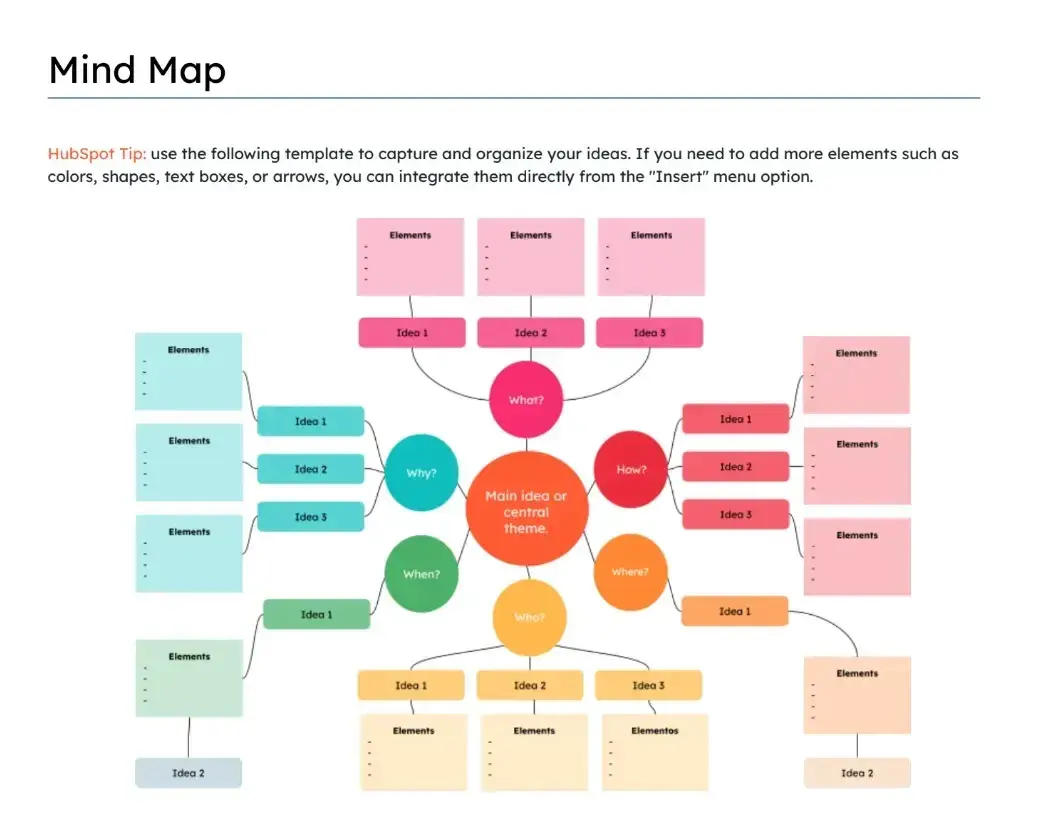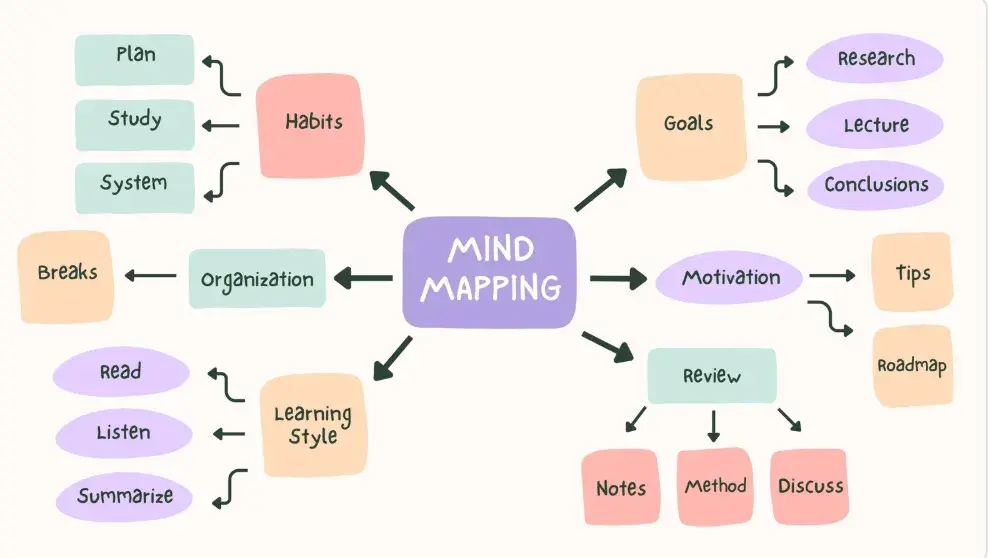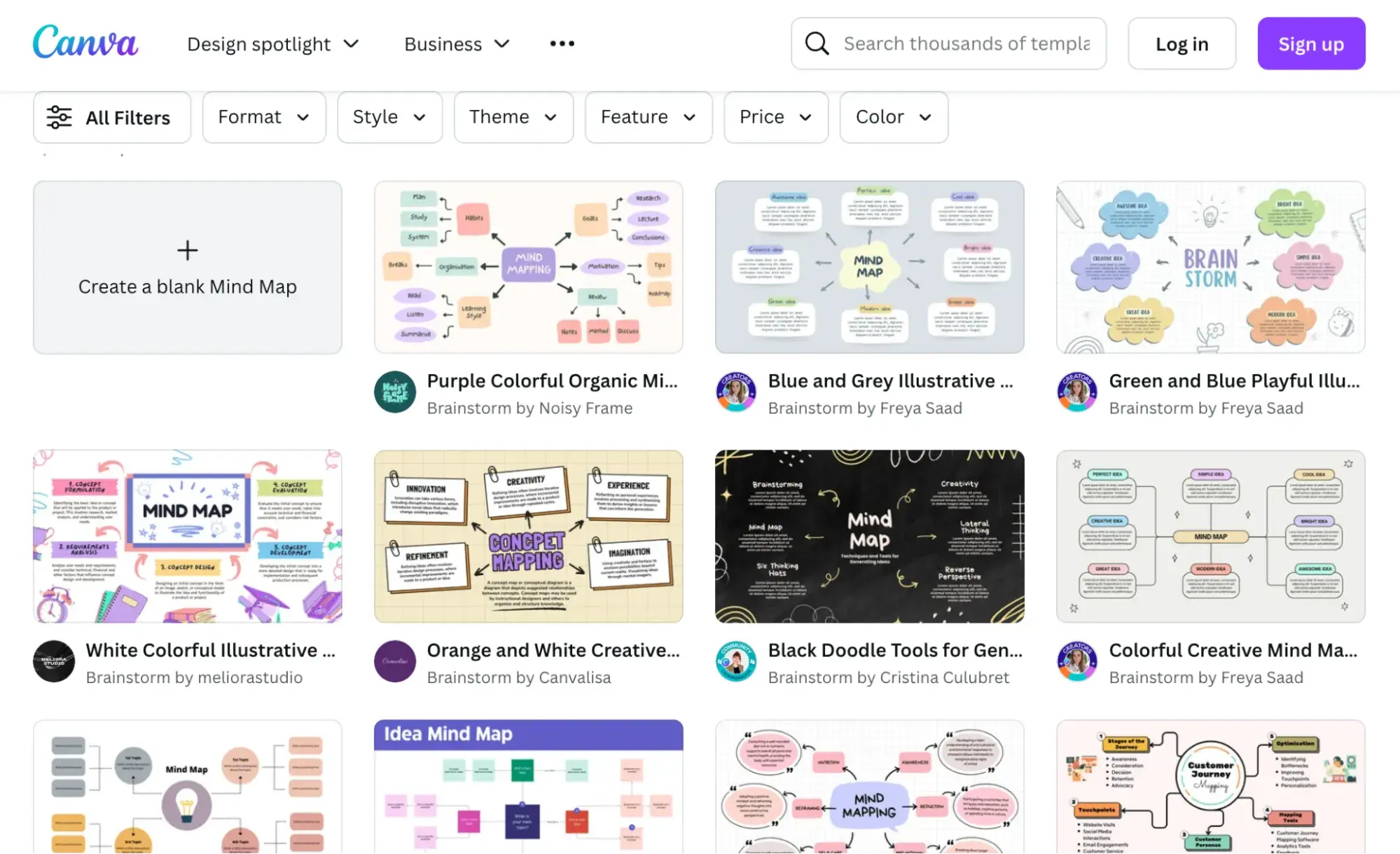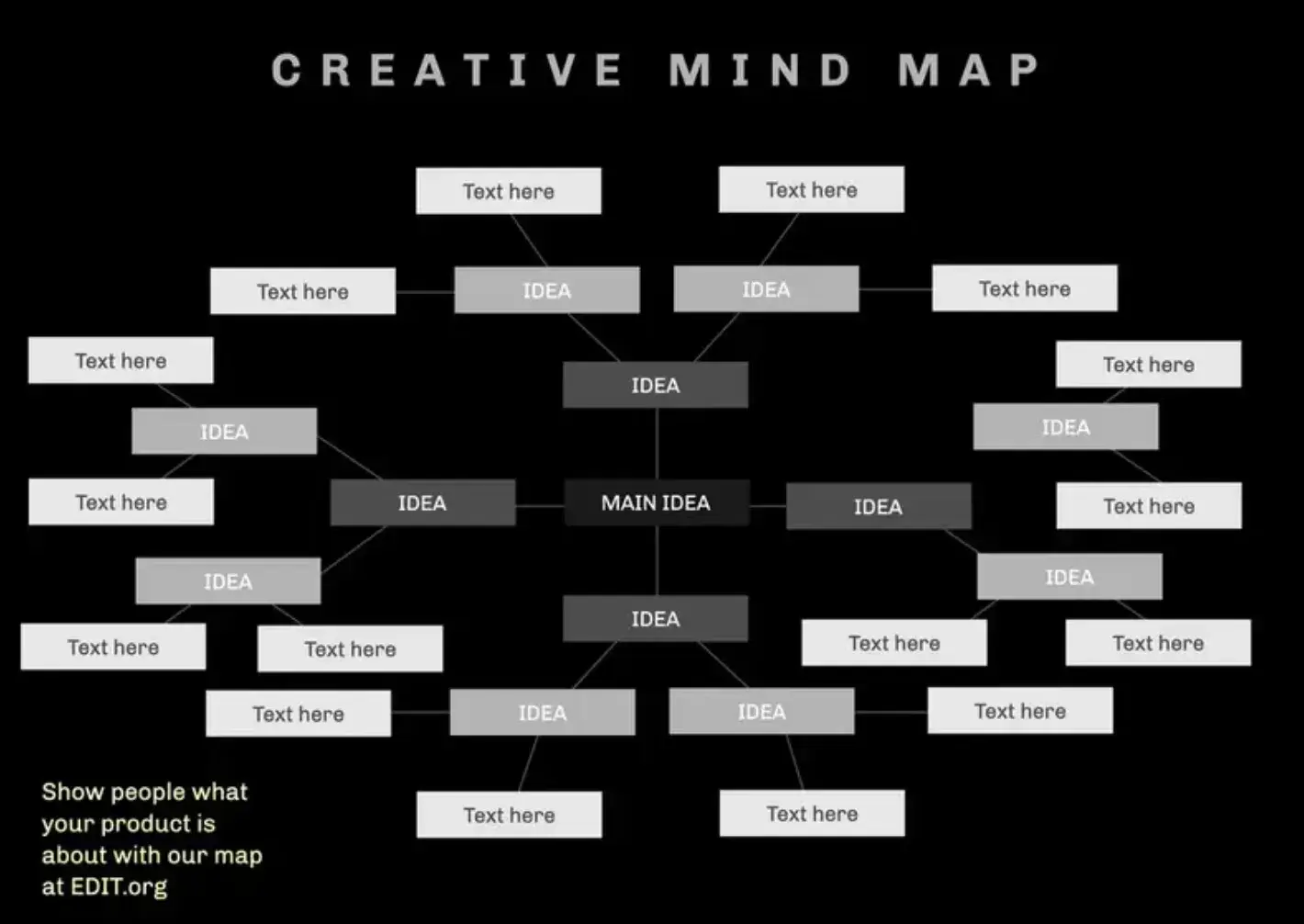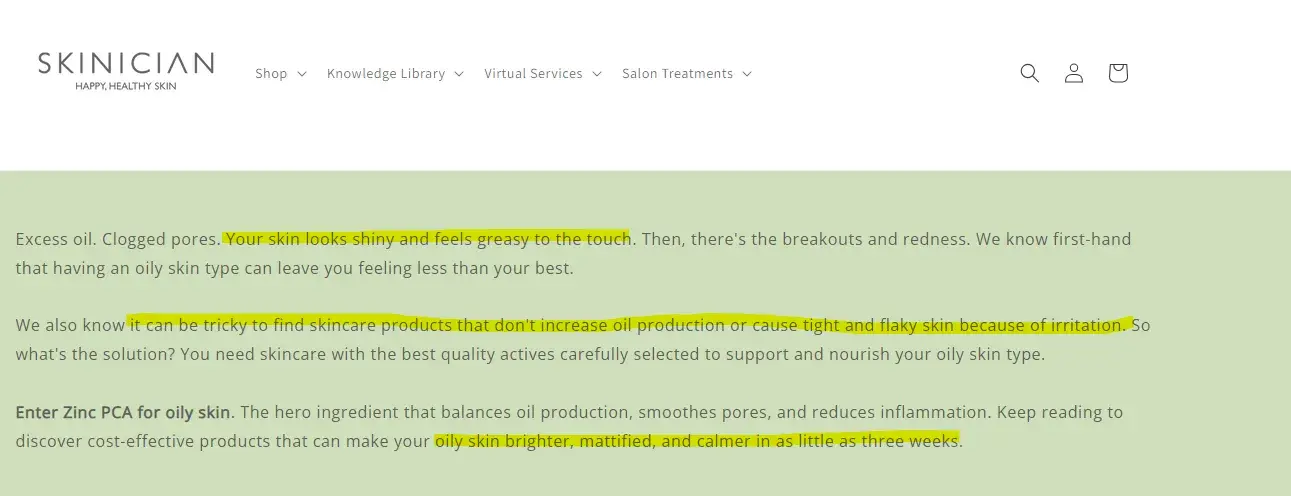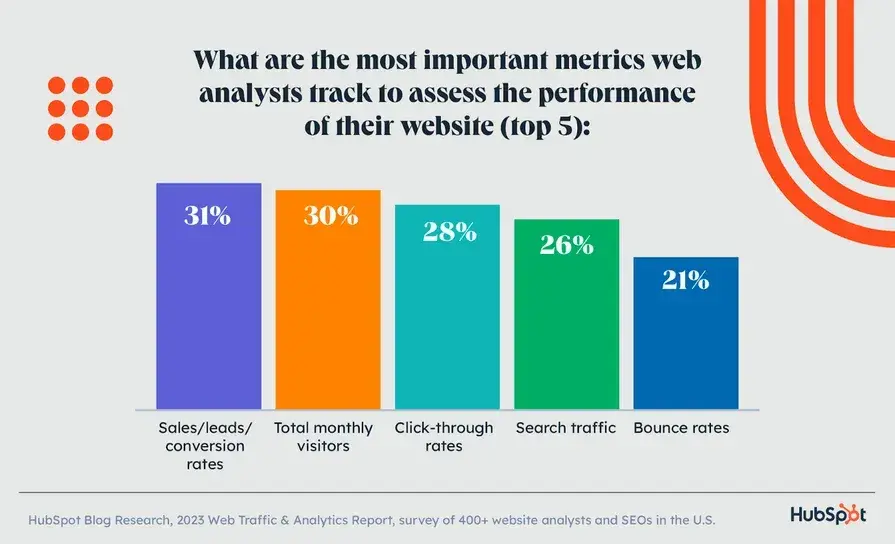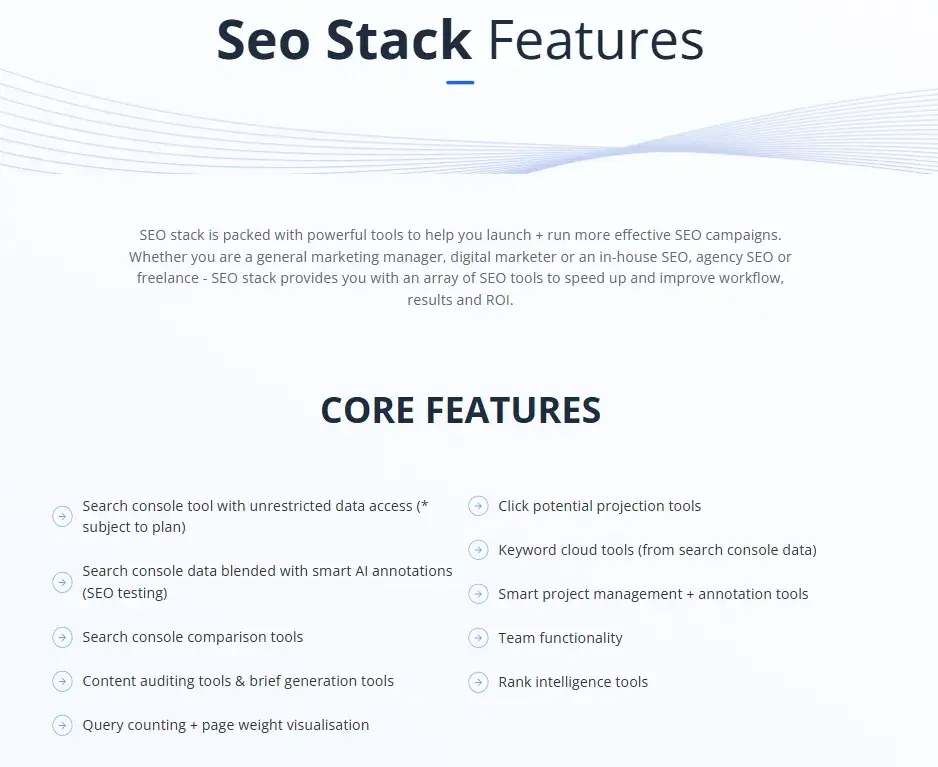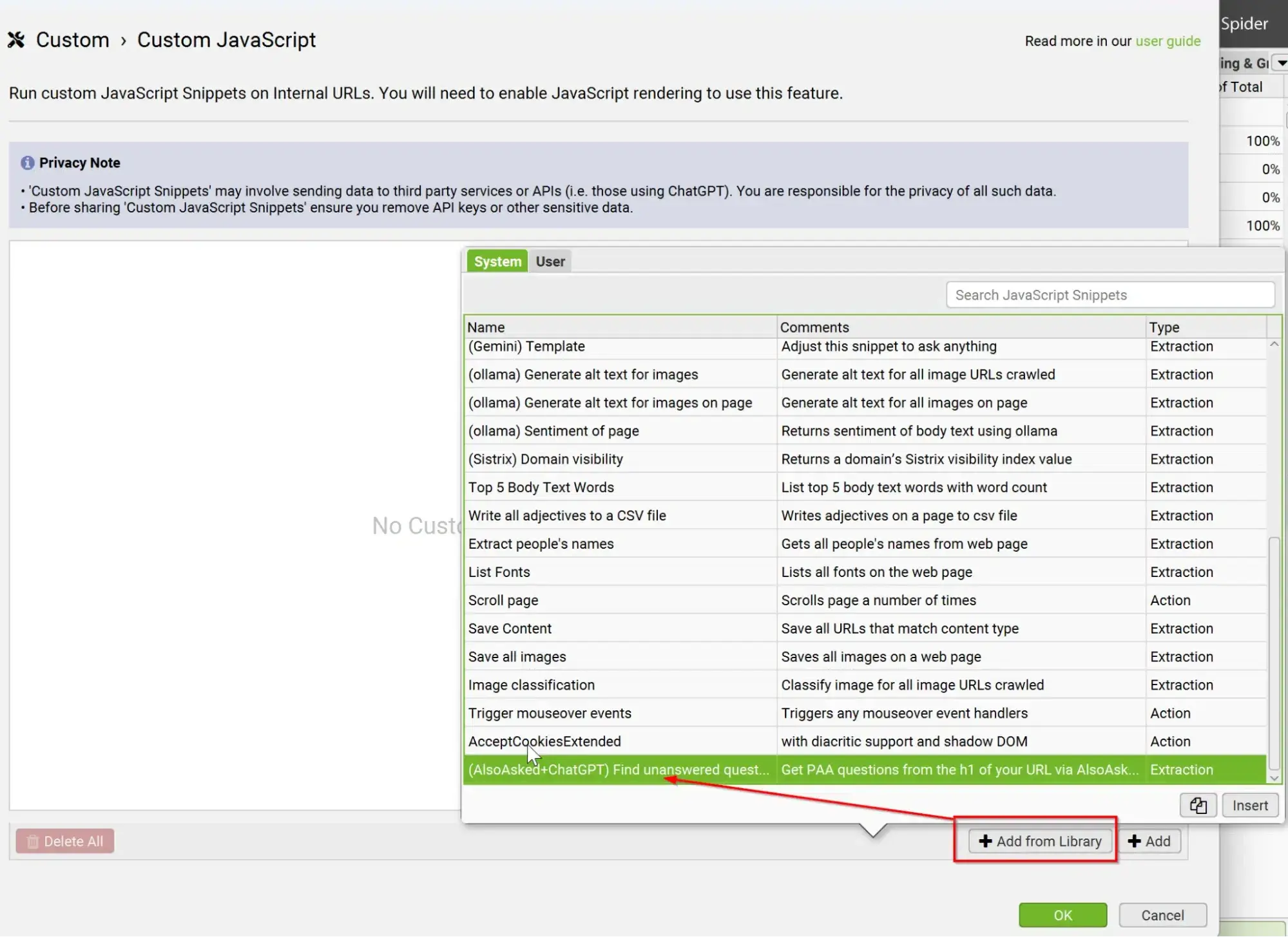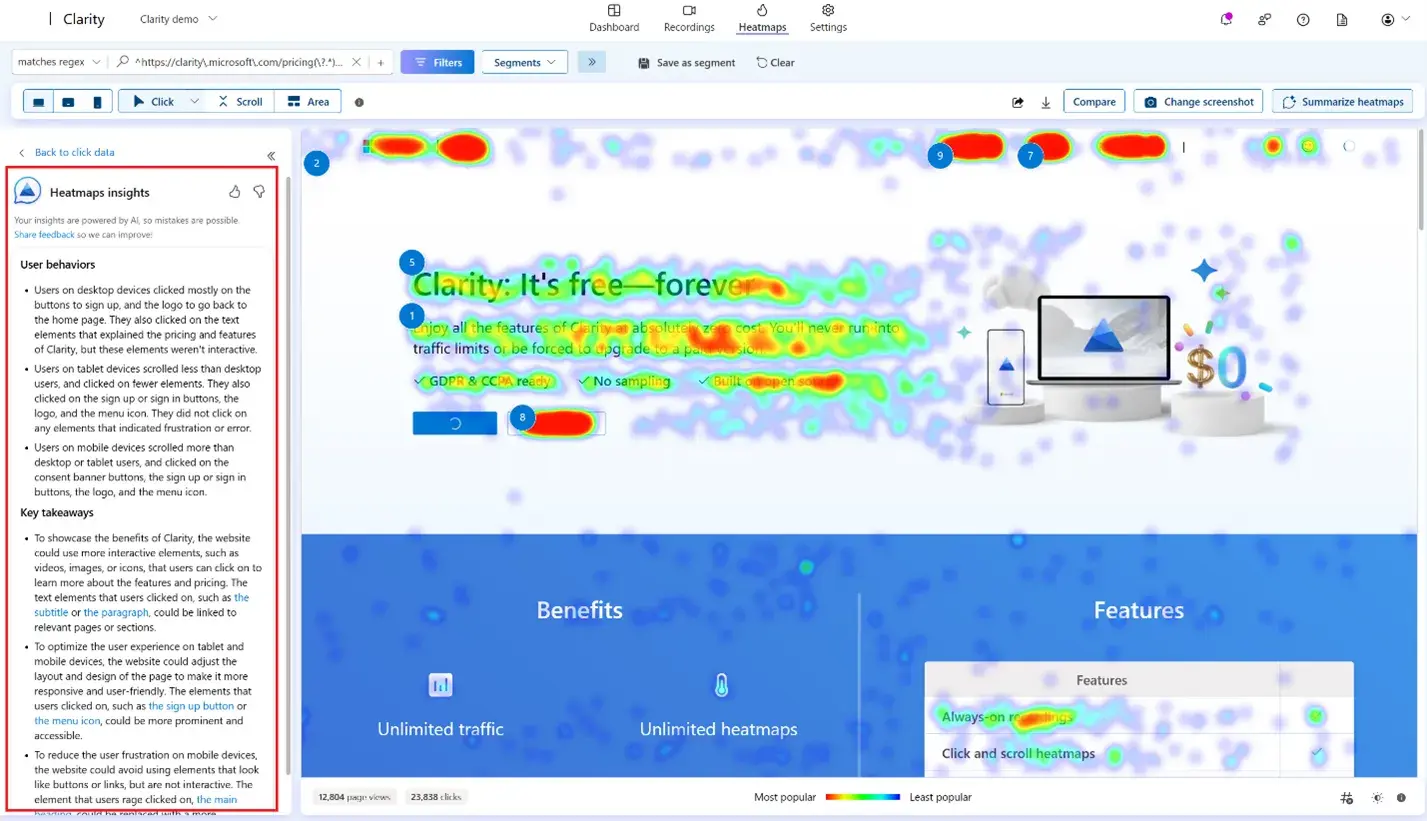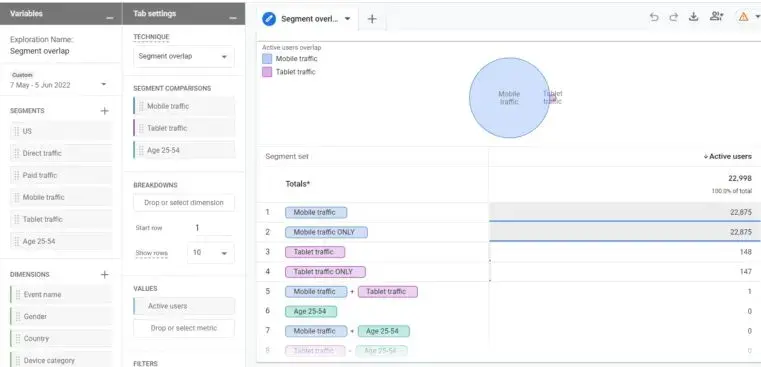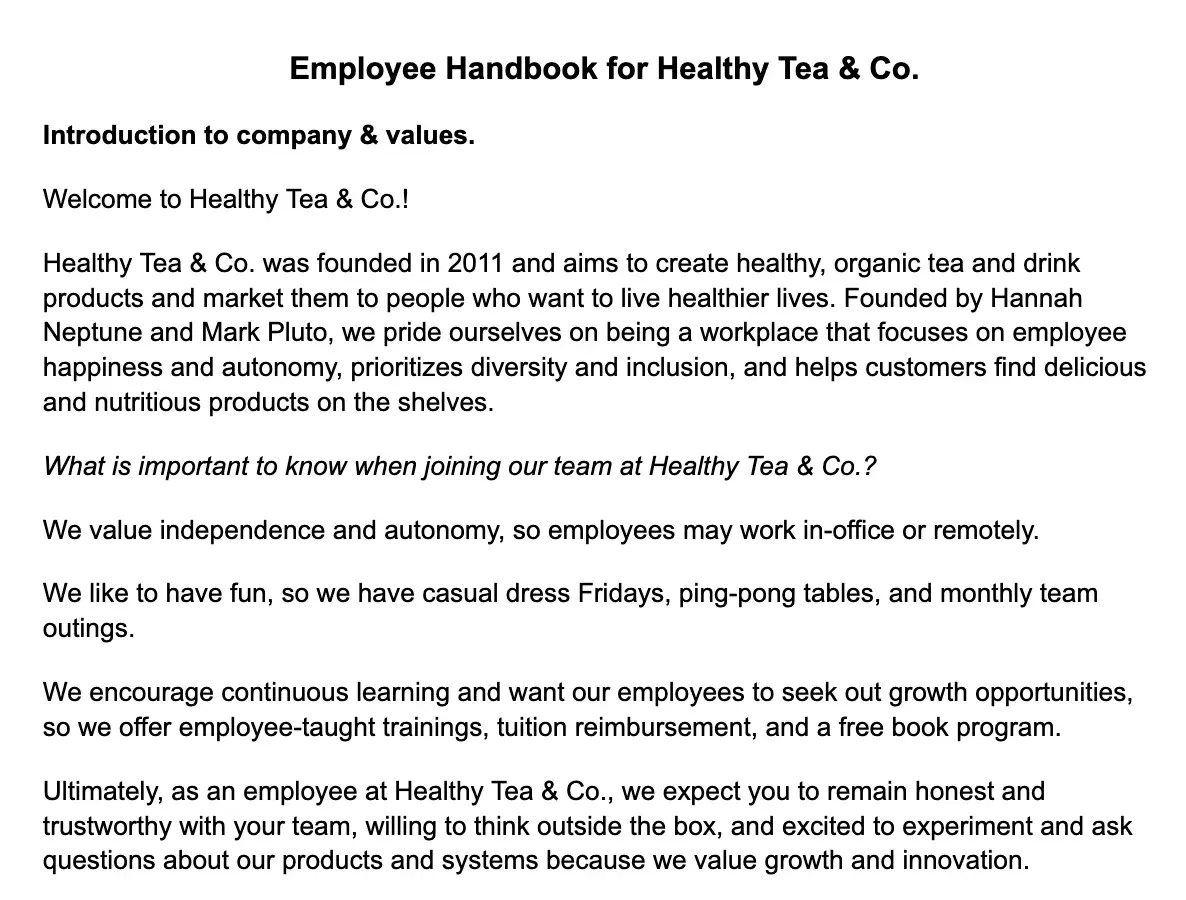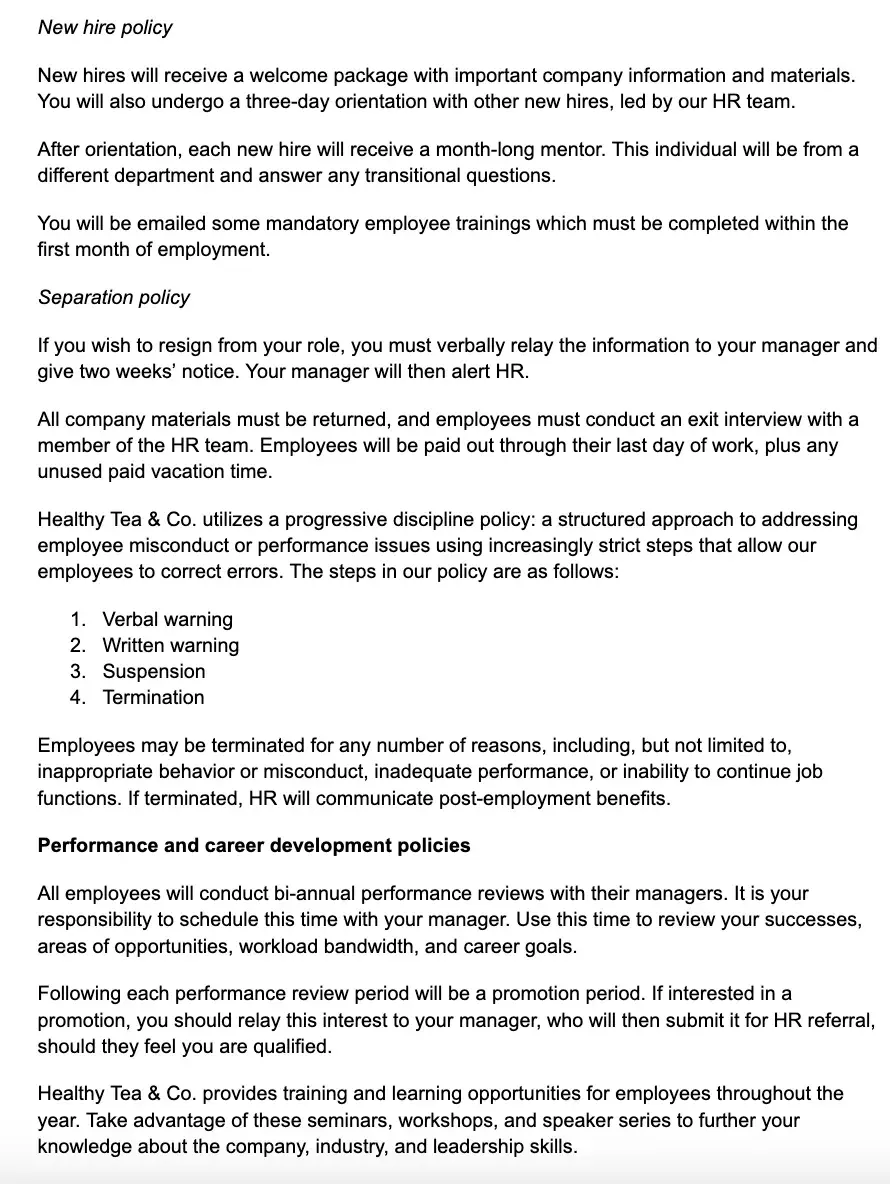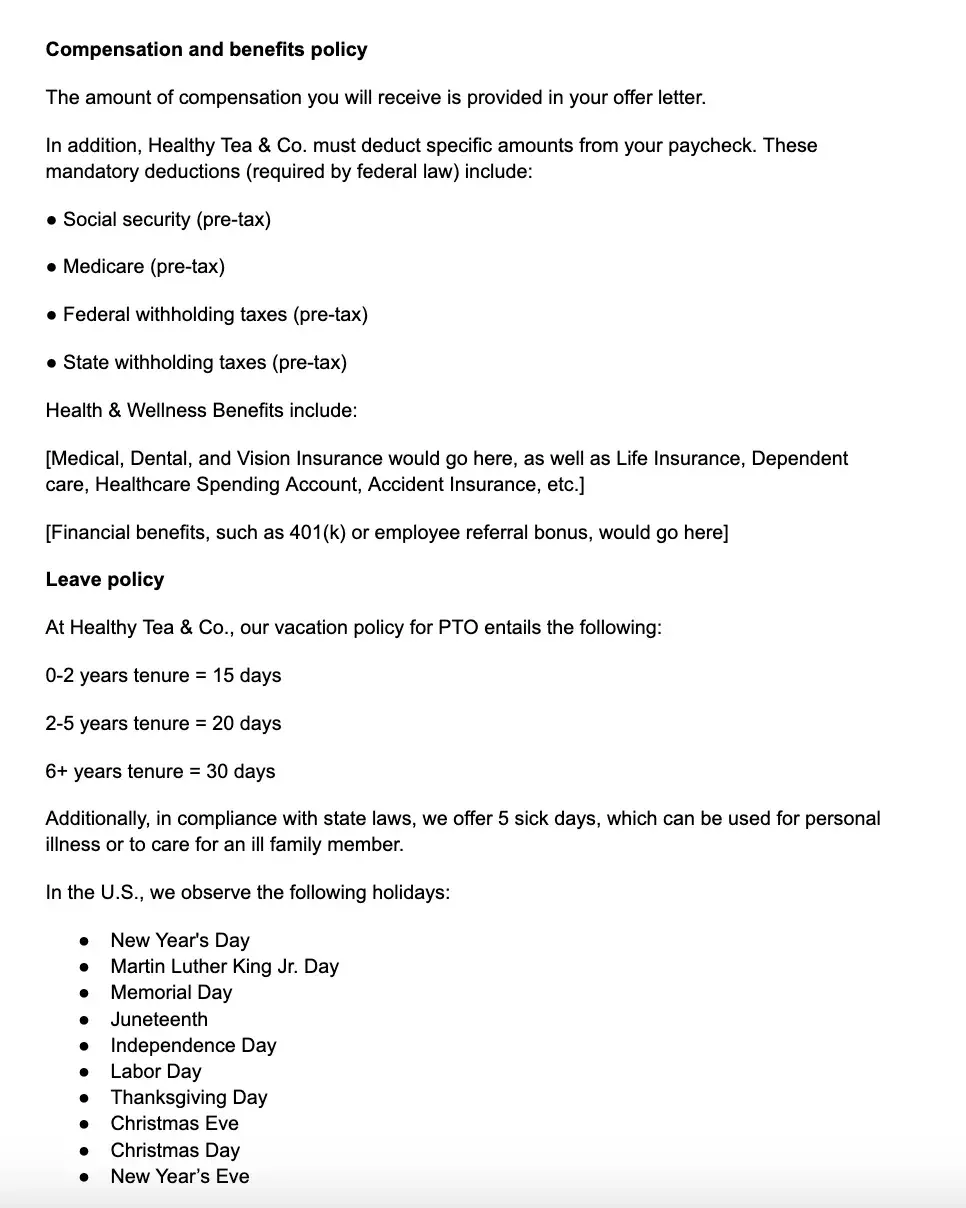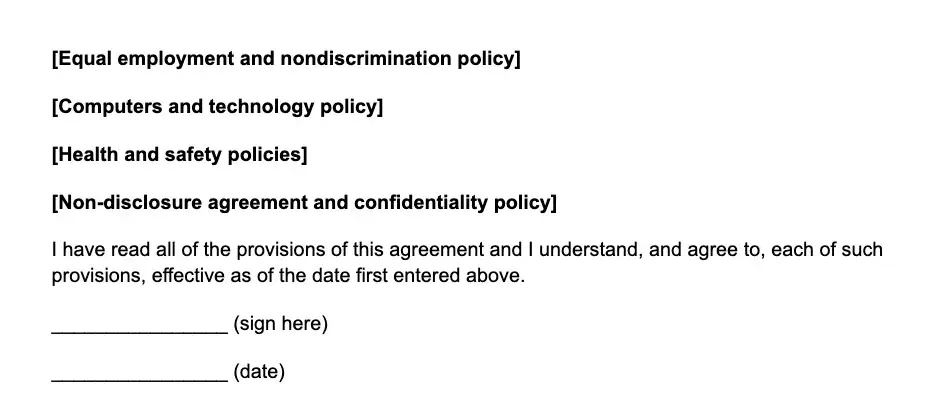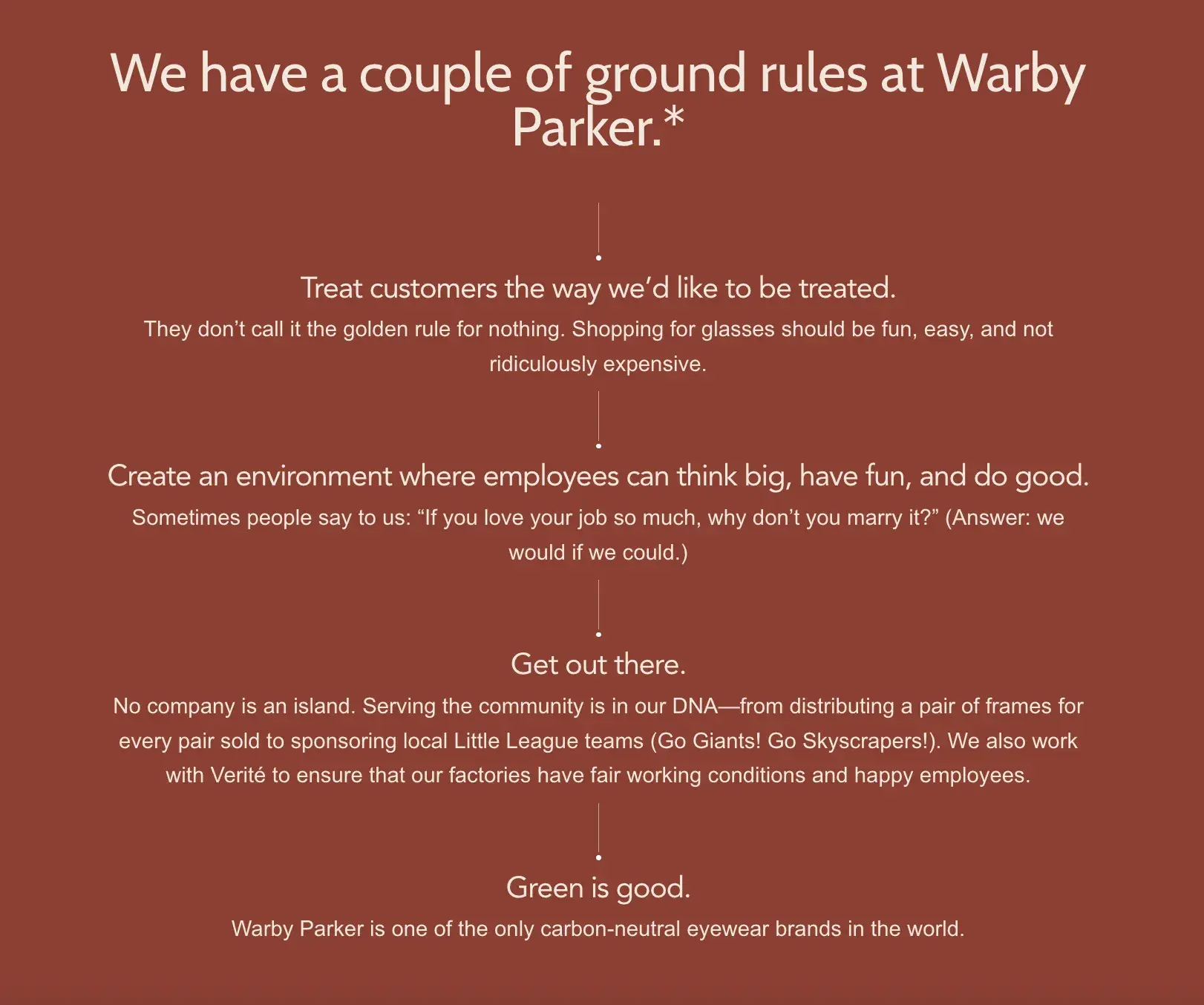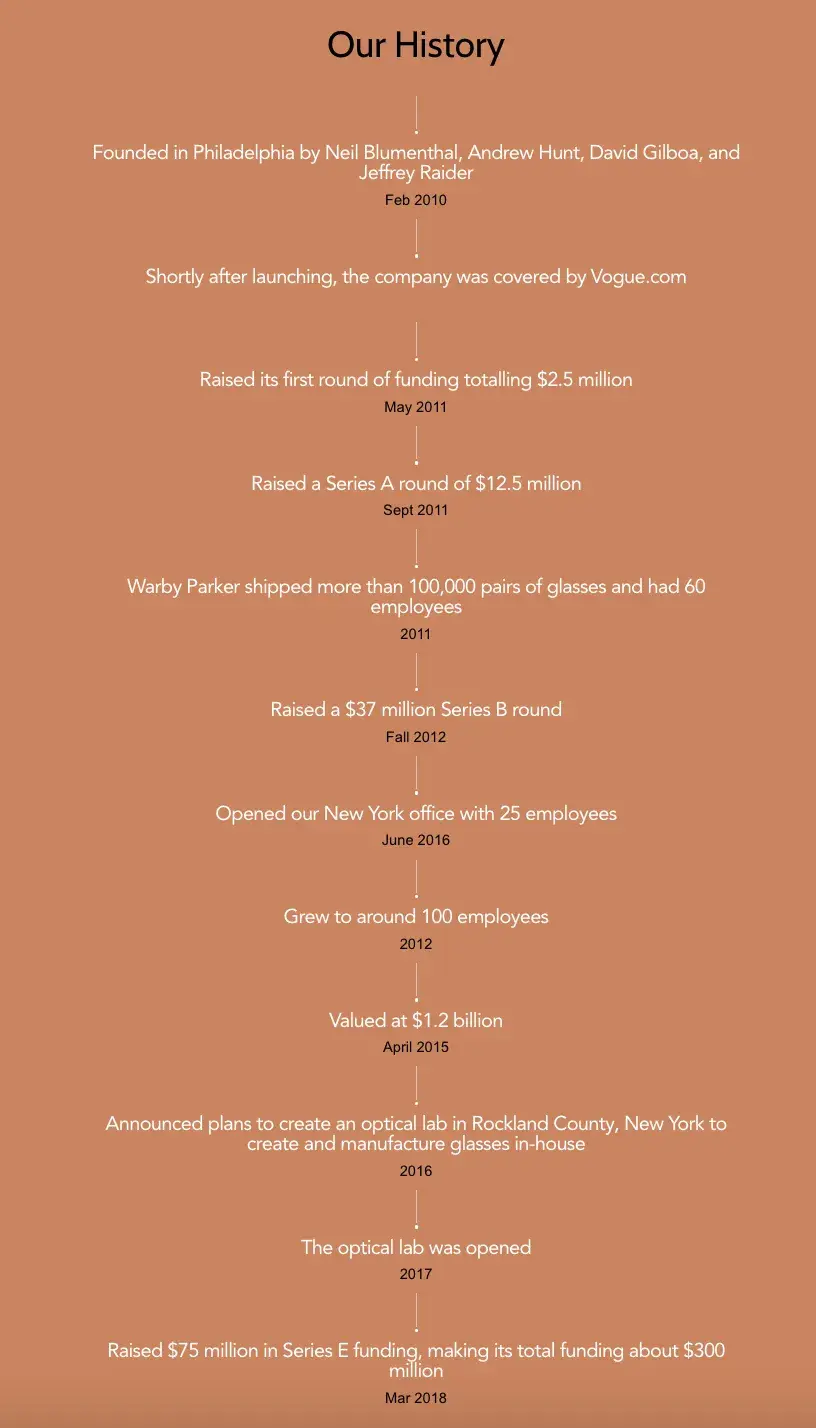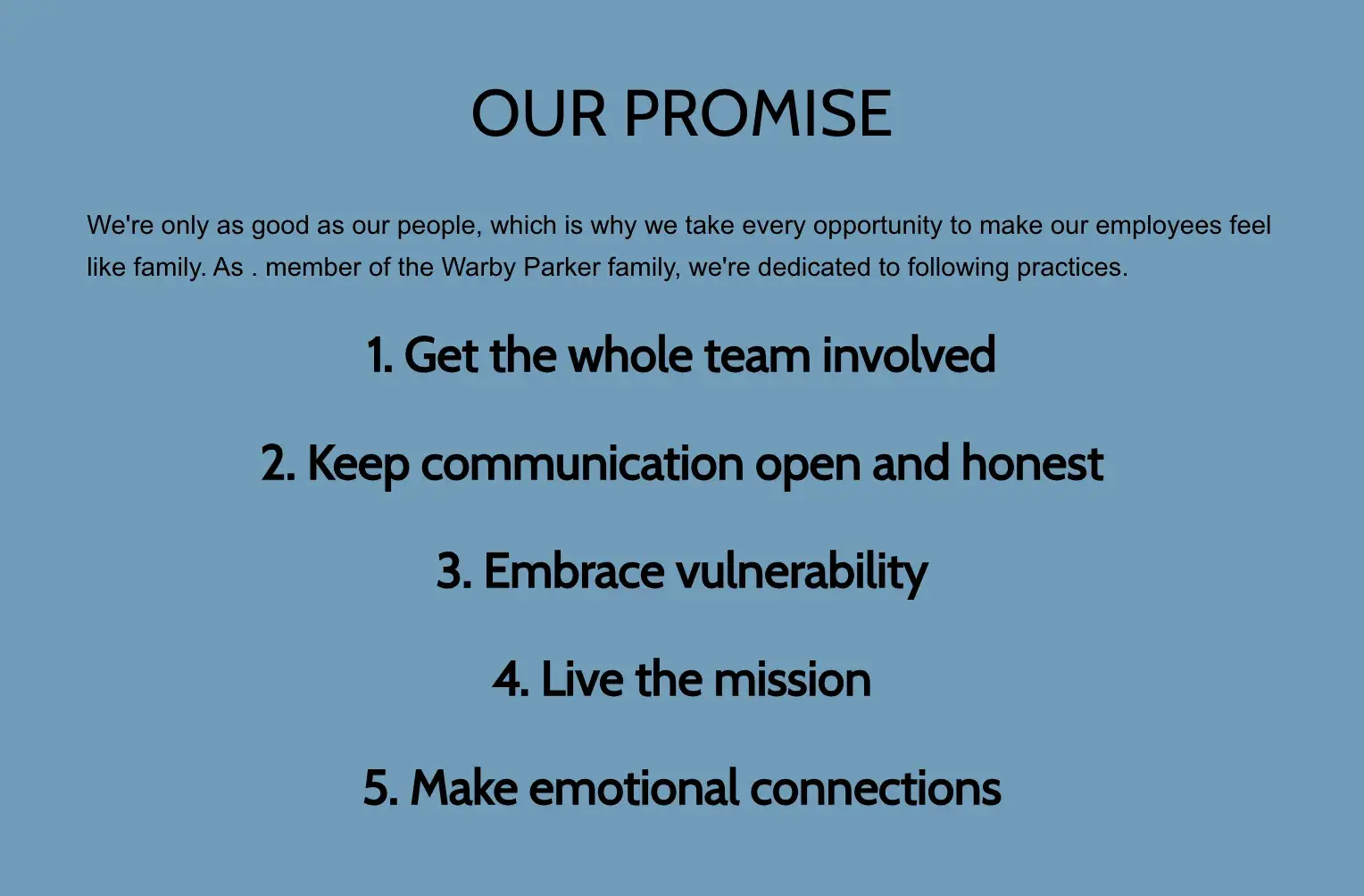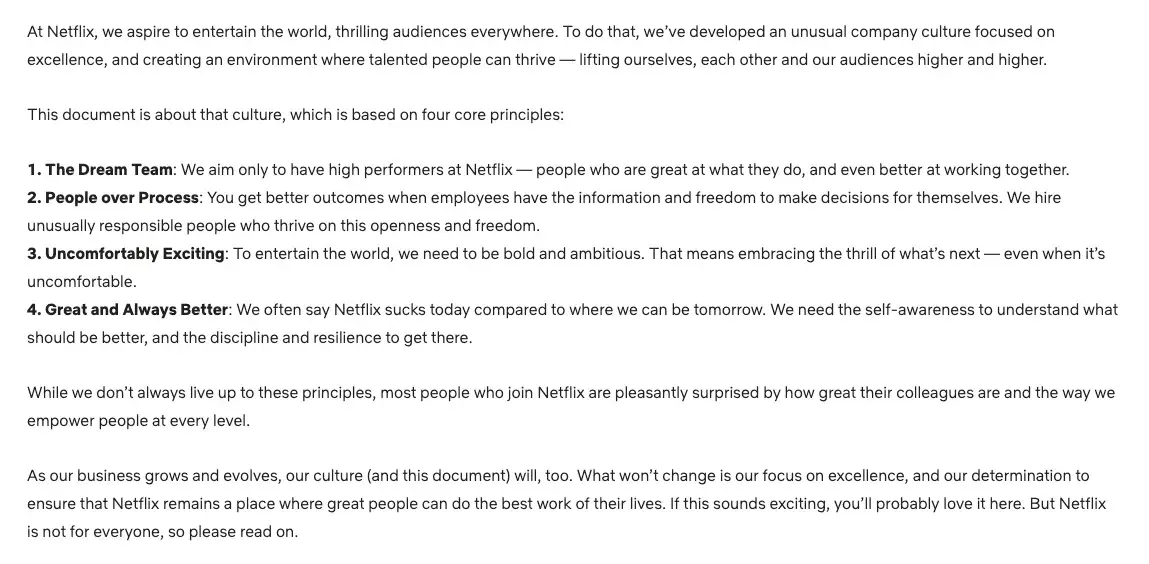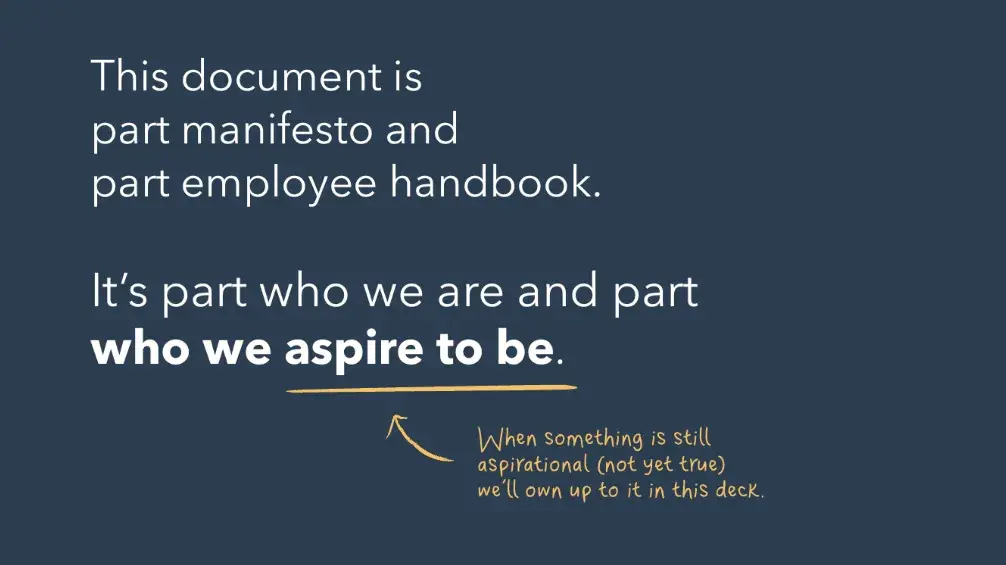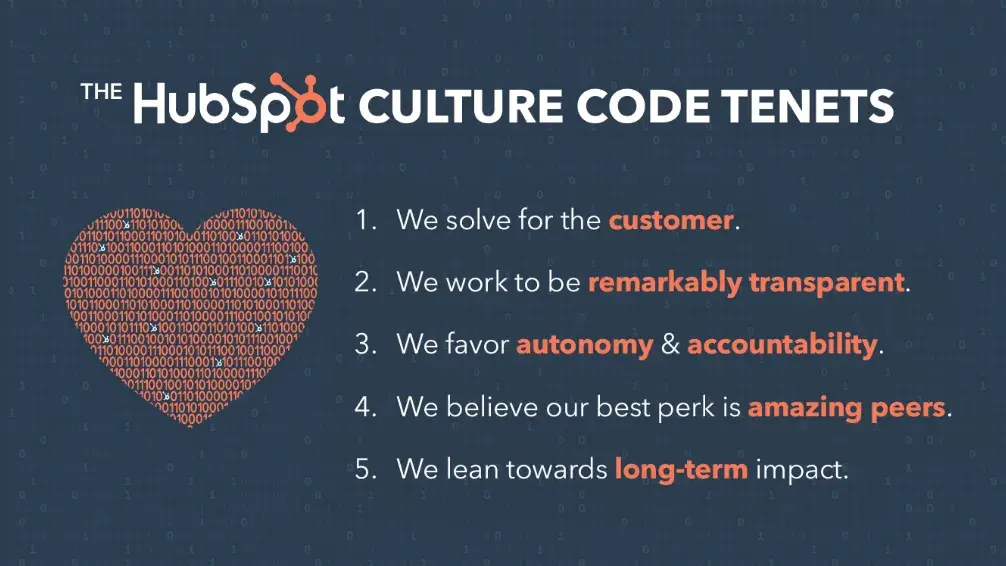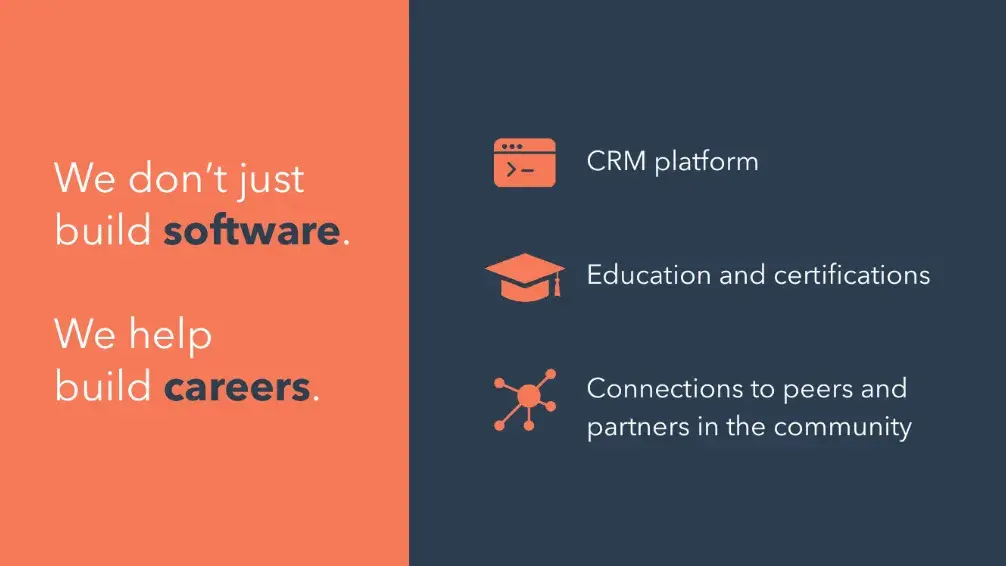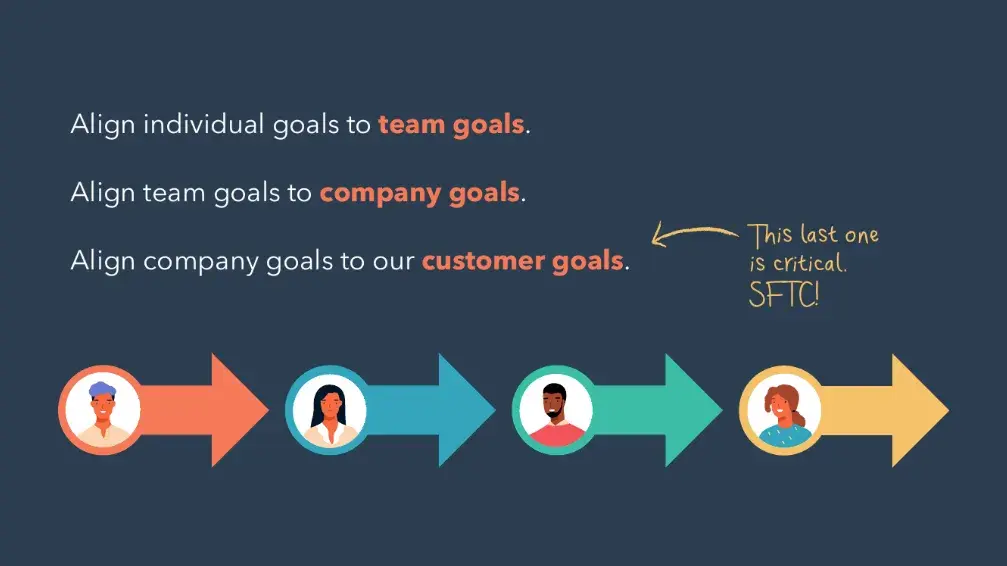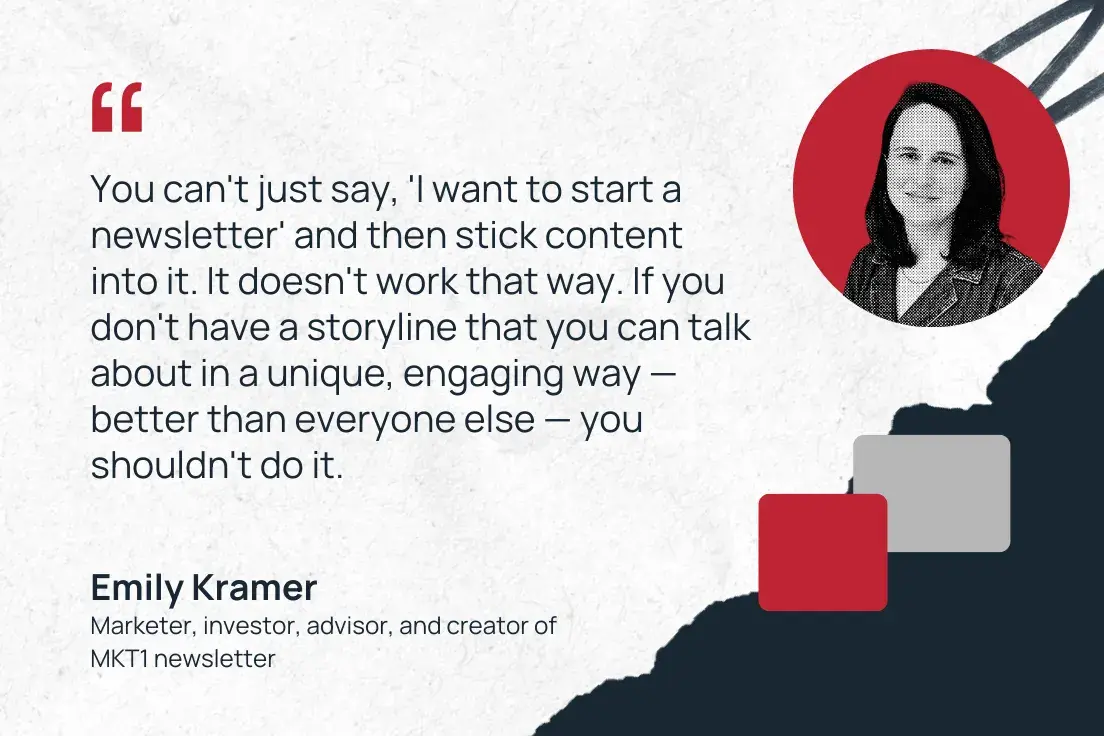I remember exactly where I was when I stumbled upon the concept of cornerstone content for the first time. It was a fresh winter’s morning in late December, and the sunshine glistened over the frosted ground … Okay, I kid, I kid.
So, the cornerstone content model isn’t exactly ‘Moon Landing’ material. But, it did completely revolutionize how I think about and implement content strategy.

As a junior content marketer, it gave me my first logical framework for creating, organizing, and managing content production. Before then, it kinda felt like I was throwing content ideas at the wall until something, anything, stuck. There was nothing to “hang my hat on,” so to speak.
Aside from a logical framework, cornerstone content also gave me a tried and tested method to increase search engine visibility for my clients. I also know for a fact that cornerstone content formed part of the SEO content strategy that still drives millions of visits to the HubSpot blog today.
Interest piqued? Cool! Please keep reading to learn from me and some incredible leaders in the SEO industry.
Table of Contents
What is cornerstone content?
Cornerstone content is the most important content on your website. We‘re talking about the best of the best, your magnum opus, the articles or landing pages you’d bend over backward to place in front of your ideal customer or reader‘s eyeballs.
In short, it’s content you want organic searchers to come in contact with first.
Not only does cornerstone content set the tone for what folks can expect from your brand, website, and offering, but it should also form a critical part of your SEO strategy.
Ideally, you want these cornerstone pieces to rank on page one of the search engine results pages (SERPs) for relevant queries that your ideal audience uses.
Note: You might have heard cornerstone content referred to as “pillar content,” — which, honestly, is low-key my preferred terminology. This also leads me to a little more oh-so-necessary clarification …
Cornerstone content vs. cluster content: What’s the difference?
To fully understand cornerstone content, I‘d argue you must also understand cluster content. They’re kind of like two halves of a whole that work together to form the pillar (aka cornerstone) cluster content model. Confused? No sweat, let me break this down.
A piece of cornerstone content, like an article, functions as an introduction to an entire topic category or subcategory of content on your website. Simply put, it introduces your audience to a core topic or subtopic that you already cover or plan to cover rigorously.

Source
Cluster content, on the other hand, acts as supplementary content that expands upon and supports your cornerstone content.
Example
Let’s say you run a music website. Because of the nature of the site, you often share multiple articles about various music genres like pop, metal, and punk.
In the cornerstone model, each genre would become like a different category or cornerstone topic you write about. In this example, a cornerstone piece of content might be something like “A complete history of punk music” or “The best punk music from the 70s until now.”
Meanwhile, cluster content would involve more niche articles that relate to and thus support the cornerstone content. So that might be something like “The best pop-punk songs from the early 2000s” or “American vs. British punk: what’s the difference?”
Benefits of Cornerstone Content
If you don’t already know, my panel of hand-selected content experts (ooh, fancy!) are here to share why cornerstone content can be the gift that keeps on giving.
Increase search engine visibility.
There‘s a reason SEOs joke about criminals hiding bodies on page two of the SERPs … (If you’re wondering, it’s because no one ever looks there. Yuk-yuk-yuk!)
But seriously, search engine users rarely look beyond page one.
Don’t believe me? Backlinko analyzed 4 million Google search results and found that “only .63% of Google searchers clicked on something from the second page.” Simply put, if search engine users don‘t find what they need, they’re more likely to adjust their search terms than scroll beyond page one.
Thus, search engine visibility matters. That’s why SEOs put so much effort into earning page-one ranks for our employers and/or clients. Lucky for us, cornerstone content can help.
Expert Insights
As Mersudin Forbes, a portfolio SEO director and agency advisor with 15 years of SEO experience, says, “For me, as an SEO Consultant, this [cornerstone content] is always steering towards search engine visibility. But it really does go way beyond this.”
He explains that the concept can extend to “any type of traffic or engagement you want to optimize on your web properties or other mediums such as newsletters.”
Pro tip: Check out HubSpot’s SEO starter pack for more ways to boost your search engine visibility.
Make your first impression count.
According to Netcraft’s 2024 Web Server Survey, over 1.5 billion websites are online today. Even if you only count the active sites — around 200 million — the competition for online attention is fiercer than ever.
Combine the above with ContentSquare data highlighting that the average time people spend on a website is dropping. Well, that fierce competition just got fiercer.
The crux? When you get a reader’s attention in the SERPs and earn their click, you need to make it count.
Expert Insights
Ben Goodey, the founder of Spicy Margarita Content, and I agree that cornerstone content can be your best friend here.
“I find cornerstone content really important because it’s often the first piece of content you create as a company,” says Goodey. “It sets the bar for your style and quality — and is therefore very likely to dictate how good content that follows is.”
He adds: “Because cornerstone content is also more top-of-funnel ‘ultimate guide’ style content, it’s often your audience’s first big touchpoint with you. You have the opportunity to grab a lot of attention, place your stake in the ground as a brand, and make it crystal clear to your audience who you are and how you do things. It’s a great way to connect with audiences and instill your brand from the off.”
Your friend and mine, Ryan Jones, the Marketing Manager at SEOTesting, shares how this first impression can help your brand establish authority within its space.
“The most crucial benefit of cornerstone content is that it helps your brand establish authority within its space,” says Jones.
“A well-researched, informative piece of cornerstone content positions you as an authority within your field. This helps build credibility with your site’s readers and encourages them to spend more time on your site and explore the other content you offer.”
Reduce your bounce rate.
Your bounce rate is the percentage of folks who click on one of your website’s pages and then leave without converting or visiting any more pages.
Fun factoid alert: According to the HubSpot State of Marketing Report, the average website has a bounce rate of around 37%. As for a “good” bounce rate? Jetpack chalks that up at between 26% and 40%. Meanwhile, a “bad” bounce rate is around 56% to 70%.
The good, the bad, and the average estimates aside, bounce rates can differ massively between industries and niches. So, while it’s not always the be-all and end-all, it can indicate whether a web page:
A) Matches a user’s search intent.
B) Provides a good user experience.
C) Makes a good first impression.
A + B + C = a satisfying, rather than frustrating, user experience.
Given that ContentSquare data finds one in three users end web sessions due to frustration, providing a seamless user experience should be top of mind for all publishers.
Nothing in life is guaranteed. That said, a high-quality piece of cornerstone content is more likely to reduce your bounce rate by thoroughly breaking down a topic. This will give users everything they need in one place (so they don’t have to exit your site).
And naturally, funnel users through a series of related content pieces (providing seamless next steps). All of these factors culminate in reducing user frustration.
Expert Insights
Mersudin Forbes also emphasizes the importance of making it easy for users to navigate your site through cornerstone content, ultimately aiding UX.
“Cornerstone/pillar content should be easy for users to understand and navigate to from your information architecture,” says Forbes. “Putting it at the forefront of what you would want your users to find.”
He also explains that your cornerstone content “should help funnel users to other supporting and related pieces of information.” This allows “you to cluster your other pieces of content around your core topic areas.”
The kicker? A logical pillar-cluster content breakdown is beneficial for user experience.
Assist with link acquisition.
Regarding SEO, I’m an on-page and content girl these days. That said, I actually started in link building (i.e., off-page.) I worked on multiple link-building campaigns as a guest post writer for a blogger outreach platform.
Aside from writing the guest posts, I identified high-quality and relevant sites and pitched article ideas to these publishers.
Based on this, I can tell you first-hand how arduous link acquisition can be. But there’s a reason we keep revisiting the link-building well in SEO.
According to Ahrefs, 96.55% of all pages in their index “get zero traffic from Google, and 1.94% get between one and ten monthly visits.” One of the top reasons these pages get zero traffic? They have no backlinks.
As Ahrefs puts it: “Backlinks are one of Google’s top three ranking factors, so it probably comes as no surprise that there’s a clear correlation between the number of websites linking to a page and its traffic.”
But rather than chasing these much-needed links, cornerstone content encourages them to come to you. As a writer for a high domain authority site (hey, HubSpot!) I can attest to this.
I‘m always looking for incredible content or research reports to reference because they add authority to my writing. (If you’ve made it this far, I’ve already linked to Backlinko, Netcraft, ContentSquare, JetPack, and Ahrefs.)
And I’m not the only one who thinks this.
Expert Insights
“Cornerstone content is great for link acquisition,” says SEOTesting’s Marketing Manager Ryan Jones. “Reviewing all the link-building campaigns I have run over the years, cornerstone content has always been the most successful.”
He adds: “There are a few reasons for this, but the main one is that your site’s cornerstone content is often your best content. More people are likely to link to it because of that. You can then use the cornerstone content to drive authority to other pages on your site.”
Support content repurposing efforts.
The cost of content production can soon add up — shout out to ClearVoice, who did the math so we don’t have to. For even “a minimally staffed content team,” you’ll likely pay around $197,066 per year.
Content repurposing (i.e., reusing all or parts of a content piece across different channels so it reaches new audiences) is one way to get more mileage from that investment.
That means cornerstone content aids your SEO strategy and your broader content marketing plan. Further, it can also help you earn revenue from your content investment.
For example, data from HubSpot finds that 63% of marketers say social media drives the highest ROI of all marketing channels, while 43% cite email.
Cornerstone content on your website is the ideal way to keep a steady source of content in the hopper to fuel these other channels.
Expert Insights
When I first started as a baby marketer, I was in charge of content across my employer’s blog and social media. During this time, I realized the incredible benefit of getting blog and social content to work together cohesively.
I‘d create two blog posts a month, equating to about four to eight social posts.
Not only would blog content support socials (so I’d direct folks to our company pages from there), but socials would support the blog (so I’d link to blogs in the comments of social posts.)
I will say this: Sometimes, you‘re better off creating content for a specific channel from scratch rather than reusing content initially intended for another. That said, you’ll always have ideas for socials or email when you have a bank of high-quality cornerstone website content to hand.
How to Make Cornerstone Content
Here‘s my tried and tested strategy for creating cornerstone content in eight steps. It covers the research, strategy, and production elements, as well as a little bit about content tracking.
I’ve also got some more juicy insights to share from our experts.
1. Choose your core topics.
If I were to map out an SEO content plan for a new website using the pillar (aka cornerstone) cluster model, I‘d start by choosing three to five key topics.
These topics are the overarching areas I’d naturally want to cover at length on my website. I’d also want to ensure they align with my product, service offer, and brand.
Pro tip: Ryan Jones also suggests operating in your “zone of genius” when choosing topics for cornerstone content. “In a business context, your zone of genius refers to the most fulfilling activities that bring in the most money,” says Jones.
At this stage, I don‘t use SEO tools yet because they can overcomplicate the process. For now, I’d like to keep it as simple as possible. That‘s because I’m trying to boil down a site to its most essential parts.
The crux? Rather than getting super granular here, I‘m looking for a bird’s eye view.
As a recap, my chosen overarching topics will become my primary content pillars. Each of these pillars will need cornerstone or pillar content pieces within them. They’ll also naturally have subtopics requiring supplementary content (cluster content.)
Together, these become topic clusters (i.e., clusters of content pieces covering a specific topic), with the cluster content bolstering the cornerstone content.
Example
Let‘s say my website is an informational site where I educate folks about marketing. Some key topics I’d likely discuss under the broader banner of marketing that work to my “zone of genius” might be:
- Organic search
- Copywriting
- Social media marketing
Each of the above would become a content pillar. For organic search, a rough breakdown of a topic cluster, including cornerstone and cluster content, might look something like this:
- Cornerstone content 1: An ultimate guide to SEO
- Cluster content 1: What is off-page SEO?
- Cluster content 2: What is on-page SEO?
- Cluster content 3: What is technical SEO?
To be clear, I wouldn’t start mapping out specific content clusters at this stage.
I am showing you another example because the more you see these topic cluster breakdowns, the easier it will be to get in the right mindset. The right mindset means you can separate cornerstone from cluster pieces more easily.
2. Don’t forget audience research.
Now you have your cornerstone or pillar topics mapped out, you might be itching to dive into keyword research.
But I wouldn‘t recommend this until you’ve checked in with your audience first. (Feel free to skip this step if you already have a clear picture of your audience’s wants, needs, and pain points.)
Audience research matters because successful content resonates with your audience. To create resonance, you don‘t just want to rely solely on keyword research tools and their data sets.
Don’t get me wrong, I love me some keyword research tools. But at the end of the day, they can only estimate search volume (aka potential user interest) for search terms.
Long story short, I‘d always rather hear from my real audience about their questions than work based only on educated guesses through SEO tools.
Of course, that’s not to say you can’t then use these common audience questions to inform your keyword research.
Example
A few ways you can check in with your audience include:
- Speaking to them directly
- Social media surveys
- Forums like Reddit or Quora
I personally love to engage with customer support or sales teams. These teams often have direct contact with customers, so they’ll know about common customer queries, support tickets, and other frequently asked questions.
Pro tip: I used to run marketing workshops for local businesses a few years ago and would always dedicate a massive section of the sessions to audience questions. If you can do this activity, I highly suggest it! I got some incredible content inspiration I wouldn’t have thought of otherwise.
And the resulting pieces still drive traffic to my personal blog.
3. Conduct keyword research.
Now, it’s time to warm up your SEO tools. HUZZAH! I will generally start with one topic (or cornerstone area) at a time at the keyword research stage.
In my experience, it’s easy to end up with a GARGANTUAN spreadsheet of keyword research data before experiencing complete data overwhelm, leading to analysis paralysis.
Or, in the worst case scenario, realizing a lot of your research is entirely unusable — aka a complete waste of time.
One thing I will say about this is that I don‘t work on larger-scale content projects anymore. My clients typically have a publishing volume of around four to five pieces a month.
People who work on larger volume SEO projects will likely have a different method to me. Neither is better or worse; it’s a different approach depending on the client’s needs.
For each content pillar, I‘ll aim to do keyword research for one piece of cornerstone content and around three to five cluster (or supporting) content pieces. I’ll then rinse and repeat this for up to two to three more content pillars.
And that ends up being the first sprint of a cornerstone content plan.
Example
Let‘s return to my previous example. I’m mapping out content pillars for a website, publishing content about marketing, and focusing on the organic search pillar.
Initially, I’m sticking with my draft pillar-cluster idea from step one, focusing on keyword research for the pillar content piece:
- Cornerstone content 1: An ultimate guide to SEO
- Cluster content 1: What is off-page SEO?
- Cluster content 2: What is on-page SEO?
- Cluster content 3: What is technical SEO?
My preferred keyword research tool is Keywords Everywhere. In my opinion, you really can‘t go wrong with the price, and it suits my keyword research style perfectly.
Plus, as a writer, I’m constantly stumbling upon hidden gems while researching in the SERPs, so even if I’m not doing the strategy, I can feed these keywords back to the strategist if they want them!
To get started, I‘m going to double-check that the Keyword’s Everywhere Chrome extension is turned on and set to the correct region. For this example, I‘m using ’United States.’
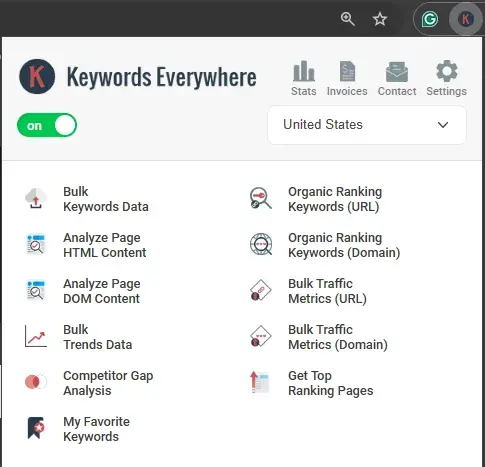
I will walk on the wild side and make an educated guess at the search term ‘SEO guide.’ The term brings up a decent amount of search volume.
But the competition is too strong for my liking. You can estimate this using the cost per click (CPC) or the Competition metrics in Keywords Everywhere. You’ll see these under the search bar.

You can also look directly at the SERPs. At a glance, the websites ranking for this search term have such high authority and expertise on this topic that it would be almost impossible to rank alongside them. (That is unless you were also a site with high authority and expertise in this area.)
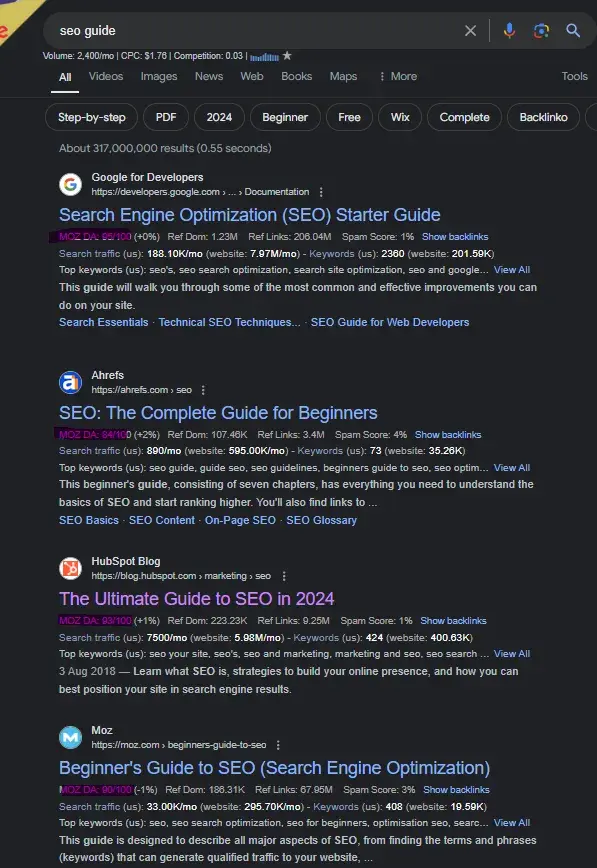
Based on the above findings, it’s time to look for hidden gems on the right-hand side of the browser. Here, Keywords Everywhere shares “People Also Search For,” “Topical Keywords,” “SERP Keywords,” “Related Keywords,” and “Long-Tail Keywords.”
By “hidden gems,” I‘m looking for low-competition keywords with decent enough search volume to justify becoming pillar content.
That said, I like to remain flexible here. If the keyword research takes me in another direction that will benefit the intended audience, so be it! As the saying goes, “We can’t fight the waves, but we can learn to surf.”
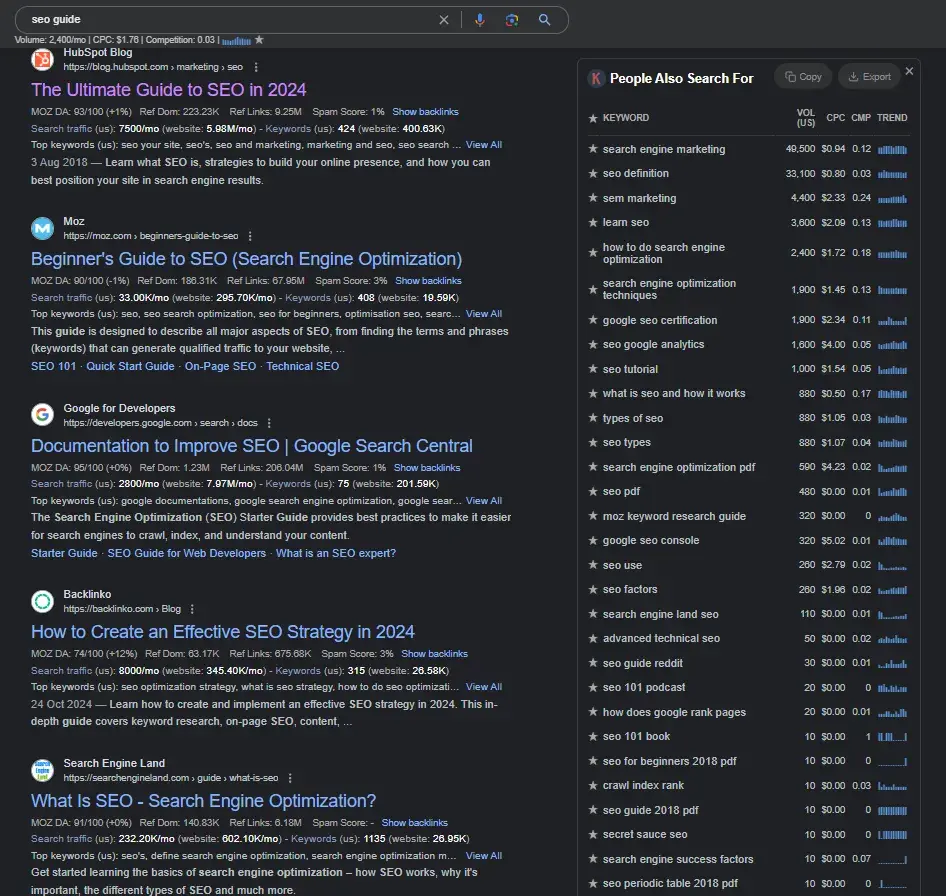
I‘ve scoured through some longer tail keywords, and the “SEO guide” subject, in general, is super competitive. So, I’m taking a diversion.
My first new piece of cornerstone content within the organic search cluster will now be about the different types of SEO. I’ll break the initial keywords for this piece down in the following way:
Target keyword. Types of SEO in digital marketing – 50 monthly search volume
Related keywords.
- Types of SEO in digital marketing with examples – 10 monthly search volume
- Types of search engine optimization – 880 monthly search volume (Because high authority sites dominate the SERPs, I see this as a longer-term investment. That‘s why it isn’t my target keyword, even though the search volume is higher.)
Pro tip: To ensure an idea warrants an entire article, check the results pages for the target keyword. At first glance, I can see that Google is prioritizing pages dedicated to answering this query. That’s opposed to this query forming only part of a broader piece of content, as a single H2, for example.
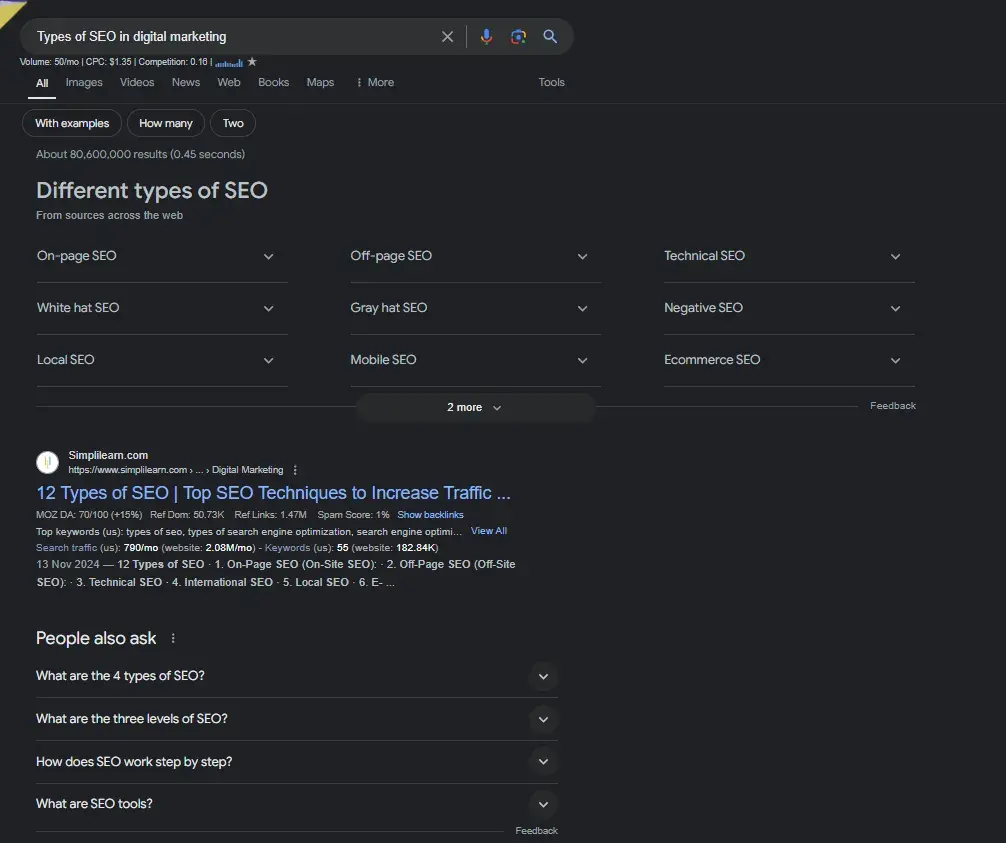
4. Differentiate cornerstone vs. supplementary content for your topic clusters.
Okay, this is an awkward step to separate because if you‘re like me, this usually runs in tandem with your keyword research. (I’m pretty much parsing out cornerstone and supplementary content throughout my keyword research.)
However, as I said in the keyword research stage, my way isn‘t the only way! So I’m excited that Mersudin Forbes, who has over 15 years of experience in SEO, shared their insights on differentiating key content vs. supplementary pieces.
“Your way of thinking about ‘cornerstone’ content needs to be more about how you prioritize, segment, and structure content discovery on your website,” says Forbes. “If your users can find what they need easily, it is likely (outside of technical issues) that Search engines will too.”
Example
Forbes recommends differentiating key content “that answers the main problems you solve, vs. what pain points your customers have and ‘supplementary’ pieces of information that support your services or answers.”
He breaks it down as follows:
- Key pillar/content = cornerstone content that users should be able to find quickly within your navigation and structure.
- Supplementary/cluster content = supporting pieces you can house under the main cornerstone content pillars and use to reference between the pillar pieces of content and supporting pieces.
Pro tip: Forbes recommends using tools like Keyword Insights, “which will cluster all of the queries and ways people seek your information online/through search engines into a set of tightly formed topics and related articles, all automatically sorted by main topic pillars and clusters of content.”
5. Use a content tracker.
Once you start to get a bunch of topic clusters on the go with cornerstone content and supplementary pieces within them, you end up with A LOT of data.
That means you’ll need somewhere to store and work with the data and track content production.
Whether you follow my method using Keywords Everywhere or work with something like Keyword Insights and gather lots of data at once, this point stands.
For this topic cluster (Organic search > types of SEO), I‘d want to add the target and related keywords for the cornerstone piece of content to a dedicated content tracker.
I’d also want to rinse and repeat the above for three to five supplementary pieces to bolster the cornerstone content.
If you‘re interested, I’d look at supplementary pieces covering the different types of SEO individually that I’d featured in the cornerstone piece. That could be a piece about on-page SEO, off-page SEO, and technical SEO.
Example
I usually have a “Content Ideas” tab or similar on a spreadsheet to track pillar-cluster content ideation. Within this tab, I will typically have “Title,” “Focus keyword,” “Supporting keywords,” and “Pillar” columns at a bare minimum. I’ll also have columns to help me track the entire production process.

If someone wants a “DIY” content strategy (so I create a strategy for them to execute in-house), I‘ll add more columns. For example, I’ll include further details about URL structure and internal linking because I see business owners getting this wrong the most often.

This might be too “handholdy” for some strategists — especially for a one-off content strategy. But I want the client to implement the plan rather than have it sit gathering dust in a Google Drive folder somewhere.
Pro tip: Want to avoid getting overwhelmed by data? Break your content ideation and tracking down into smaller steps. For context, my first round of keyword research for content strategy typically includes around 12 content ideas in total.
If you publish four posts a month, that’s a three-month strategy. The specific breakdown of the 12 ideas might be something like three topic clusters, including a cornerstone piece and three supplementary pieces for each.
6. Create a content brief.
Now that you‘ve researched and parsed your cornerstone pieces from your supplementary ones, it’s time to create a content brief.
A content brief is a document that you can give to your writer(s) so that they can create your cornerstone content.
I know many folks use tools to automate content briefing, but honestly, I don‘t find them helpful. I’d much rather dive into the results pages myself to see how we can reach enough consensus to please Google while differentiating ourselves as a brand.
(Once again, my way isn’t the only way! Plenty of folks in the industry get good results from using content briefing tools.)
For me, briefing writers involves searching the target keyword directly via Google using a VPN set to the region my client is targeting. Then, I’ll quickly scan the top competitors to see what they cover in each piece.
But I’m also looking at what they don’t cover because this is where we can stand out as a brand and provide a better user experience.
Example
Never created a content brief for writers? No stress, here’s what I typically include in mine:
- My contact details in case the writer needs clarification on anything
- The purpose of the article
- Links to any documentation like style or brand guidelines
- SEO data points
- Target keyword
- Related keywords/keyword cluster
- Meta title
- Meta description (for the writer to add)
- URL
- Suggested content length
- Recommended internal links
- Article focus
- Content outline
- Suggested H2s/H3s
- Any notes under specific headings
7. Start content production.
Once you have your content brief, it’s time to pass it over to your writer and trust them to work their magic.
Remember: Every time you take a crucial action, like briefing a writer or publishing content on your website, you’ll want to update your content tracker.
Otherwise, the content production process can go unmanaged, unchecked, and get real messy real fast.
8. Update and continuously improve your content.
Ryan Jones, the Marketing Manager for SEOTesting, recommends updating your cornerstone content regularly, and I couldn‘t agree more. “All SEOs know that Google prefers fresh content,” says Jones.
“Keep your content up to date and perform regular refreshes to ensure you’re giving your readers the best content you can!”
Aside from pleasing the Google Gods, you can start gathering real performance data insights after a content piece is live.
That means rather than making educated guesses about user behavior, you can see how or if people are finding your content.
Pro tip: I recommend checking in with Google Seach Console to see what terms people are using to find your cornerstone content. If you haven’t optimized for these terms already, you can use the data to inform your content refresh.
A content refresh could be as simple as updating a few existing H2s with these terms or adding new sections to the piece if folks ask queries your content doesn’t specifically answer.
Tips for Creating Cornerstone Content from the Experts
You‘ve heard enough from me, so let’s return to our experts Ben Goodey, Ryan Jones, and Mersudin Forbes. They share their top tips for creating cornerstone content.
Consider your audience’s next steps.
“An overlooked step: what happens after the reader has read it?” says Ben Goodey.
“Your cornerstone content is your reader‘s entry point into the topic and your brand. But once they’ve finished reading, think through what next steps you want them to take.
For example, you might want them to download something useful and relevant you’ve created or subscribe to your newsletter to get more on [your cornerstone topic].”
Do in-depth research.
“Make sure the content you create is comprehensive and well-structured,” says Ryan Jones. He also emphasizes the importance of using data, statistics, and credible sources to support your points.
“Readers (and search engines, obviously) are more likely to trust and engage with informative and accurate content.”
Link to supporting content.
“Be sure to link to supporting content, too,” says Jones.
“For most sites, cornerstone content will bring in the most acquired backlinks. Don’t be afraid to link to other content to share that link equity among other pages that you want to rank.”
Factor in readability.
“Make the content readable! Don’t feel you need to have one 5,000-word article if the research doesn’t support that,” says Jones.
“Split your content up with images, videos, and expert quotes. Make sure your cornerstone content covers the topic in full, but make it readable and engaging. Make it a piece of content that users want to use!”
Remember: Cornerstone content isn’t just informational.
Some schools of thought say product or sales pages shouldn’t be classed as cornerstone content. I actually disagree with this. Why? Well, Mersudin Forbes puts it better than I could have myself.
“Cornerstone content can be mistaken for informational content only,” says Forbes. He explains that it “can also be core lines of business, core services or core products. Whatever covers the key essence of what you do and why you do it.”
Cornerstone Content Examples
Now, let‘s look at a few examples of cornerstone content. I’ll dissect why each one works and what I like about them.
1. HubSpot’s “Instagram Marketing: The Ultimate Guide”
I might be biased, but when it comes to constructing ultimate guides, HubSpot is one of the best publishers to do it. As for this Instagram Marketing Ultimate Guide, the first thing that strikes me is its comprehensive nature. That’s typically what you want for a piece of cornerstone content.
The article also opens up with some statistics showing that the piece is research-backed and evidence-based, which builds credibility right from the start.
I also like how readability has been factored in. So, for example, there are plenty of visuals, headings, and examples throughout.
2. HubSpot’s “Ultimate Guide to SEO in 2024”
Okay, now you can definitely accuse me of bias with this pick because I‘m the author of HubSpot’s Ultimate Guide to SEO.
As with the previous example, this piece is comprehensive. I did a deep dive here, from breaking down the definition of SEO to describing the different types of SEO, sharing top tips from other industry experts, and more.
I also considered the audience‘s next steps with this piece. Not only did I include relevant internal links throughout, but I directed readers to the ’Complete SEO Starter Pack‘ with a clear call to action in the post’s conclusion.
3. Sound of Life‘s “’90s Music Trends That Shaped a Decade”
Sound the bias alarm again: We’re off the races with another content piece scribed by your gal, Rachael.
In all fairness, I’m featuring ’90s Music Trends That Shaped a Decade because a) I know it’s a pillar piece and b) based on Zoe Ashbridge’s excellent SEO content strategy, my penmanship, and the exquisite work from the publisher’s editorial team, we beat Wikipedia for the featured snippet.
This example highlights that with the correct elements in place, your pillar content can even beat high-authority sites like Wikipedia. In my humble opinion, the piece works because we covered a lot of relevant information about ’90s music trends.
That said, rather than just covering keyword-driven headings mindlessly, we ensured the piece was editorial-led with a specific angle. The editorial team also did a fantastic job curating and embedding Spotify playlists and songs to break up the text and increase readability.
We also linked to supplementary content throughout the post and added relevant internal links alongside a clear call to action at the bottom of the article.

Source
Cornerstone Content Done Your Way
As with so many areas of content planning, there‘s no single way to create a cornerstone content strategy. I emphasize this because your client’s budget, needs, and publishing frequency will ultimately dictate your approach.
That said, many of the foundations stay the same. Be that the logic of parsing out cornerstone from cluster content or the art of making the final piece more engaging for your readers.
My biggest takeaway? If you‘re new to cornerstone content, I recommend experimenting with the methodology on your personal site and seeing what results you get.
I’ve given you a starting point today, but testing is the best way to learn how to do cornerstone content your way.


![]()

![Download Now: Free State of Marketing Report [Updated for 2024]](https://i4lead.com/wp-content/uploads/2025/01/db725f24-564c-483b-a28c-2d6ff9986516.png)


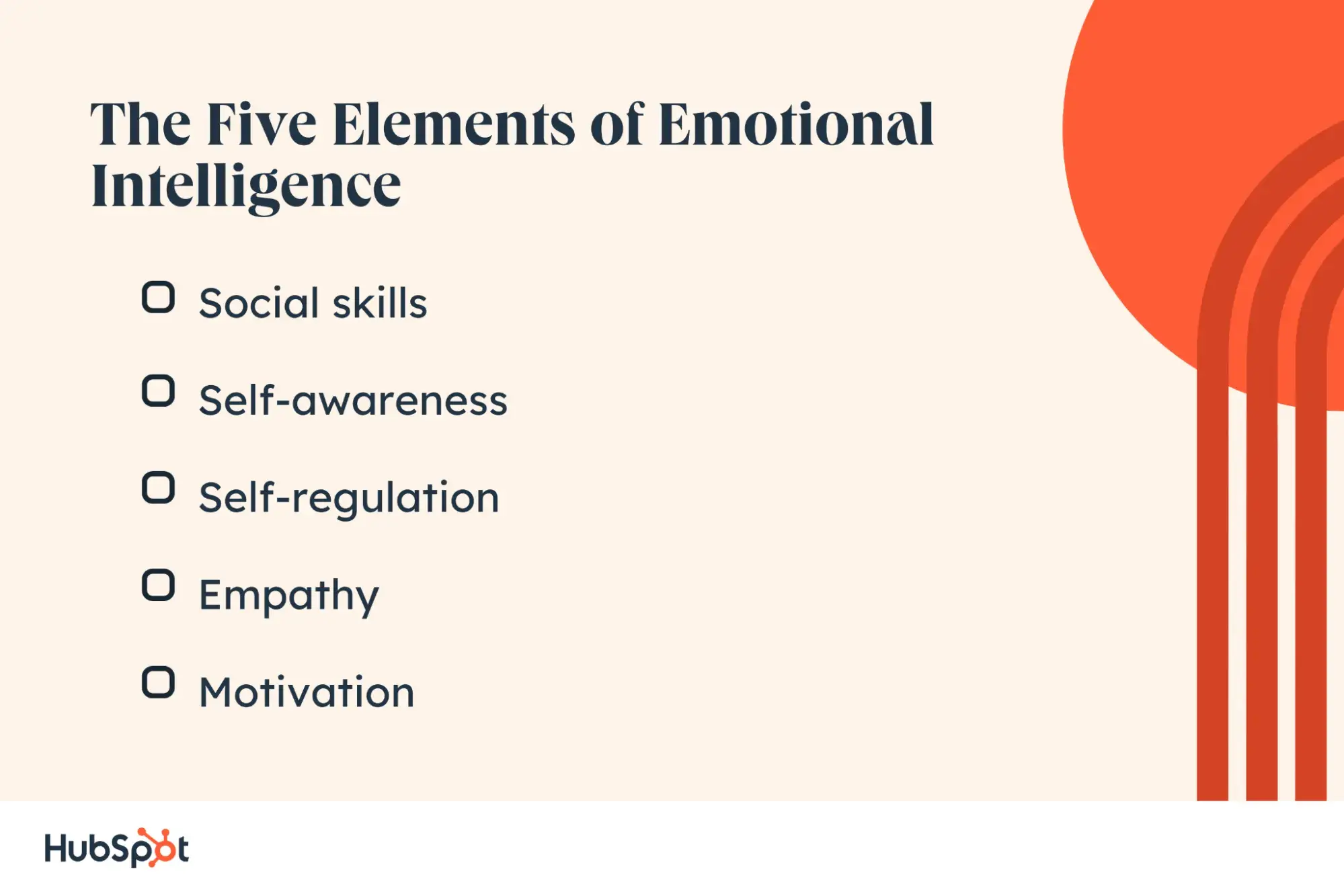
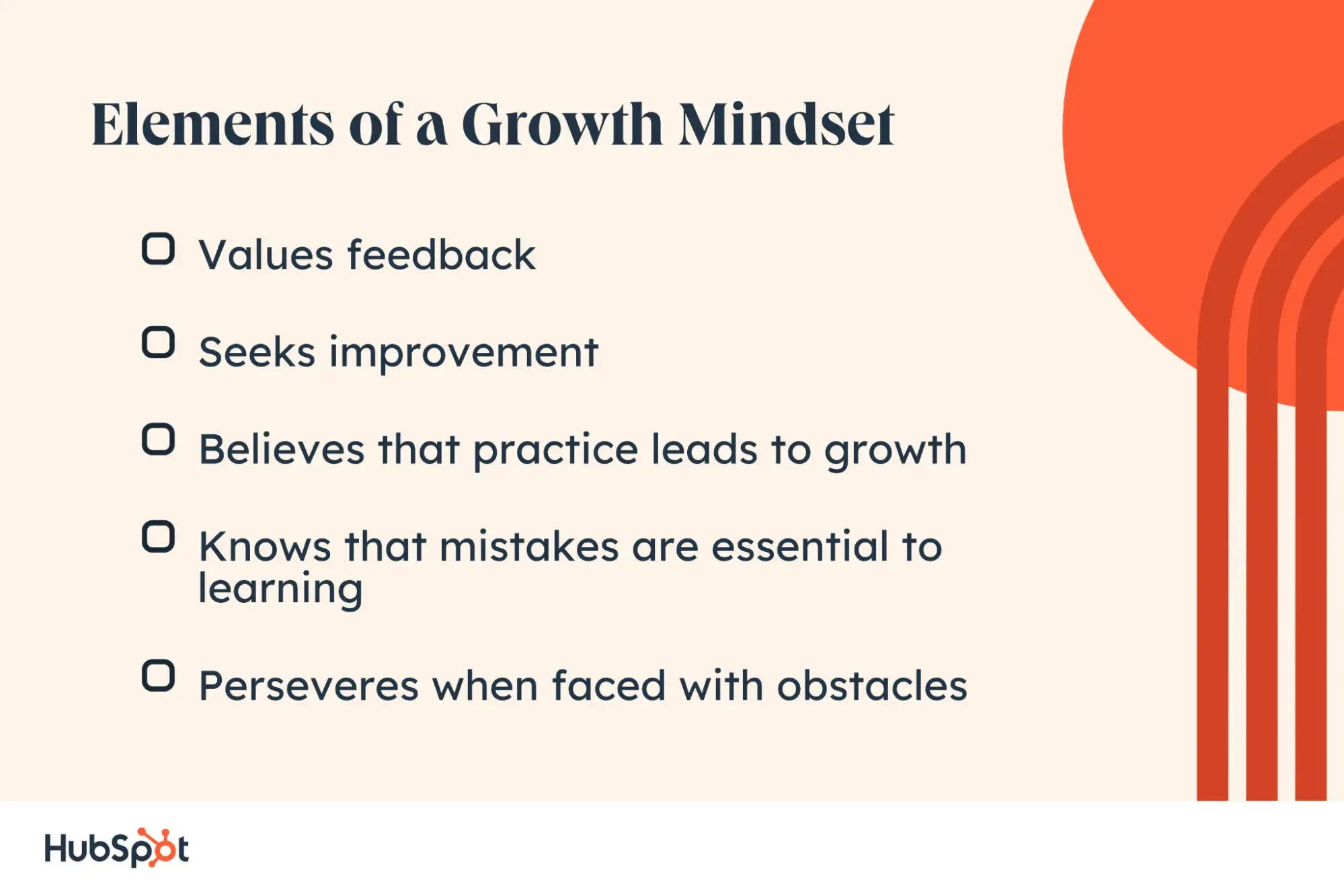
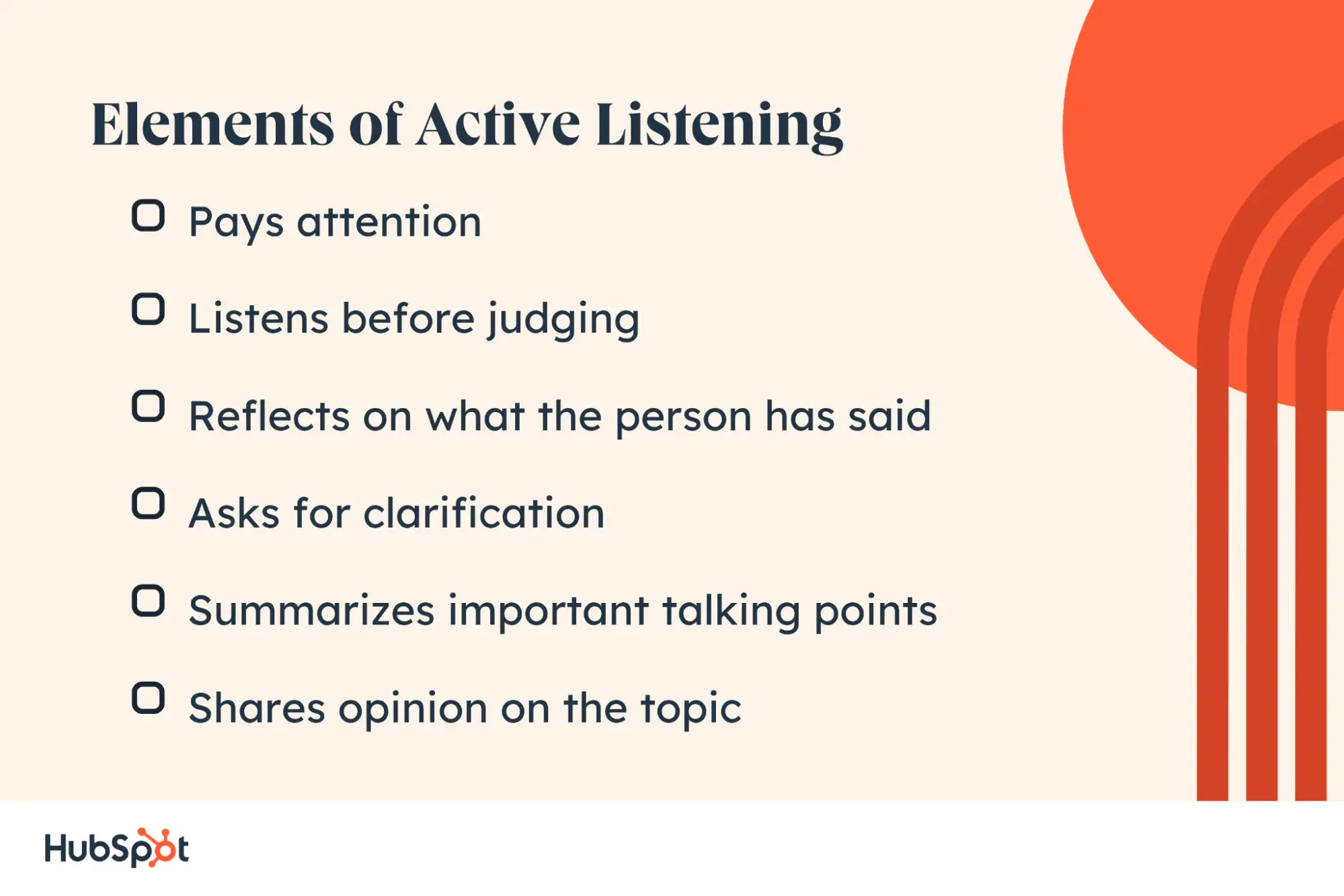
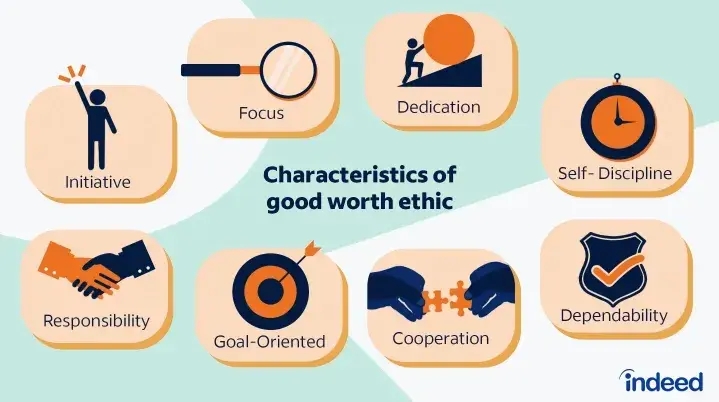




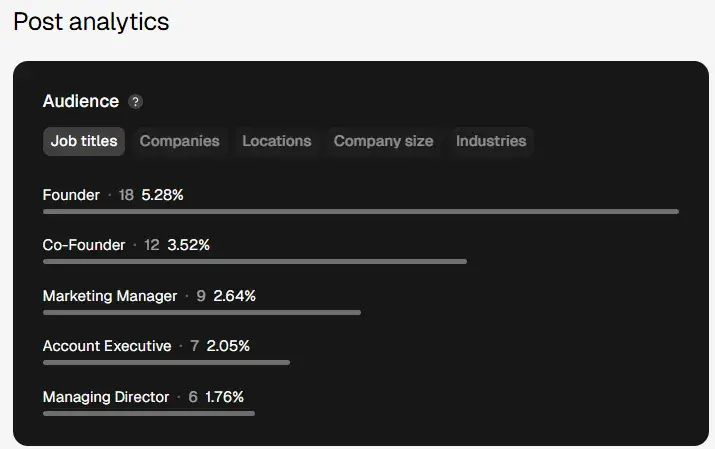

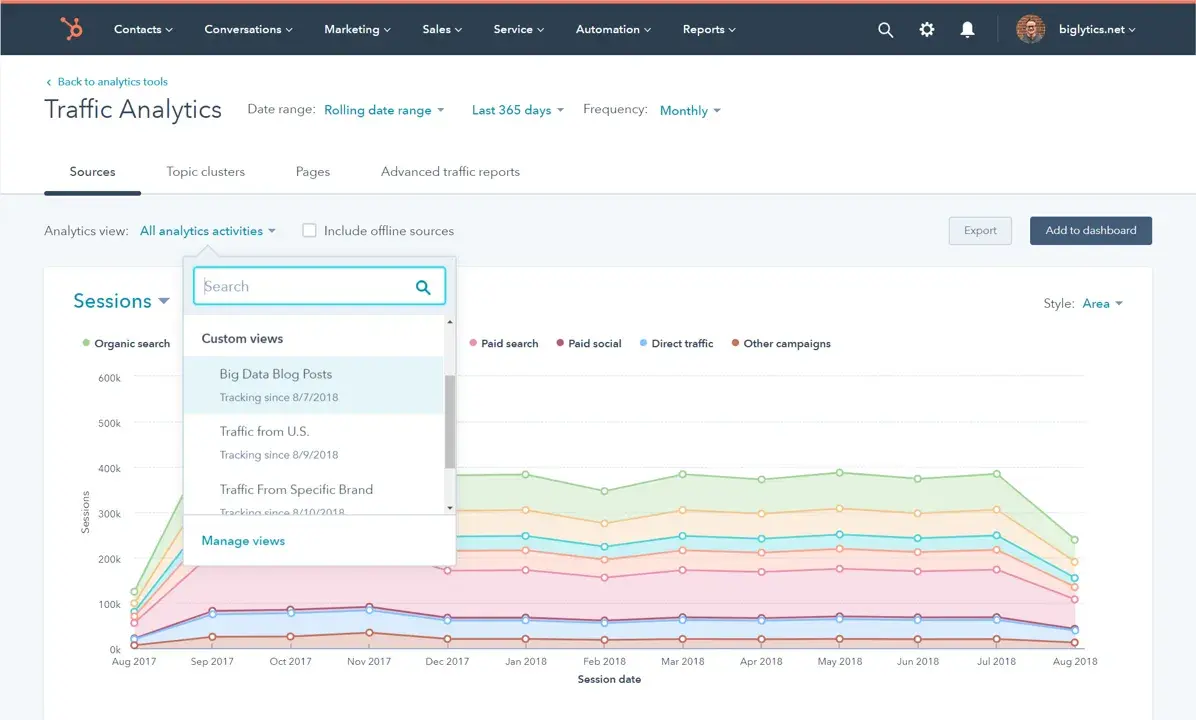
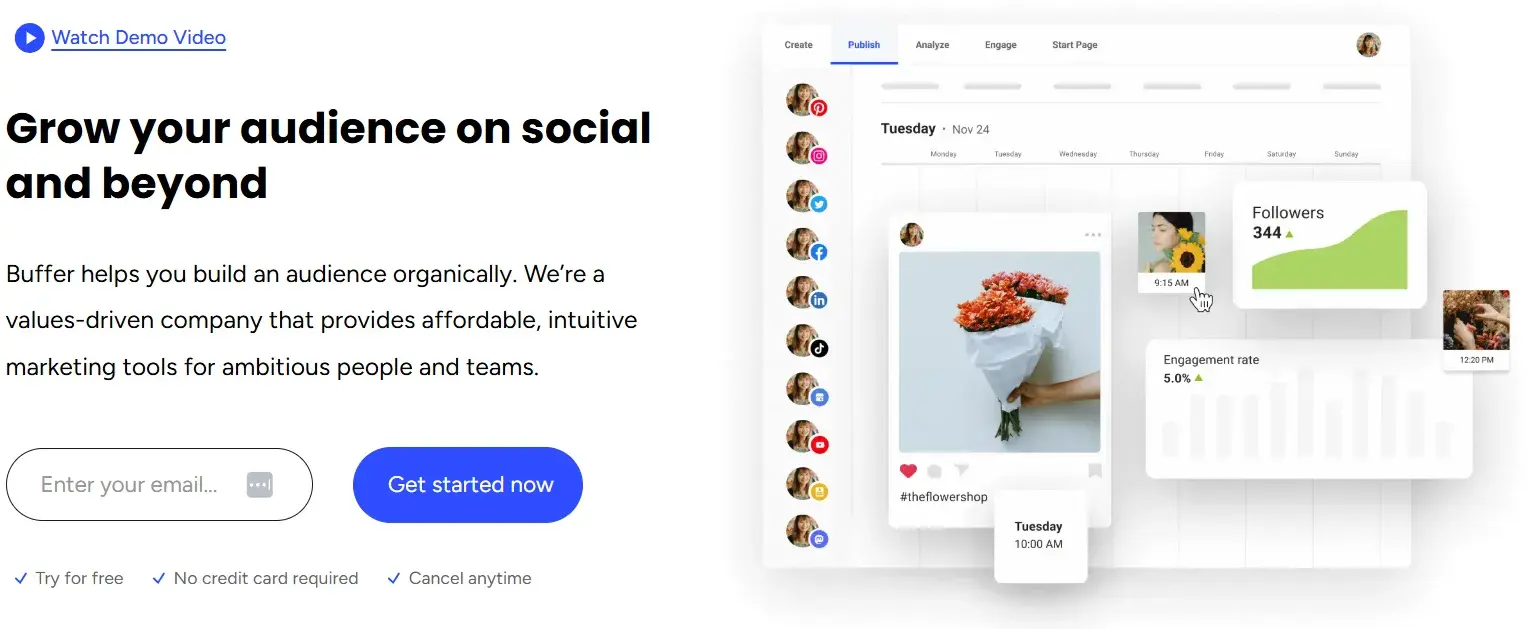
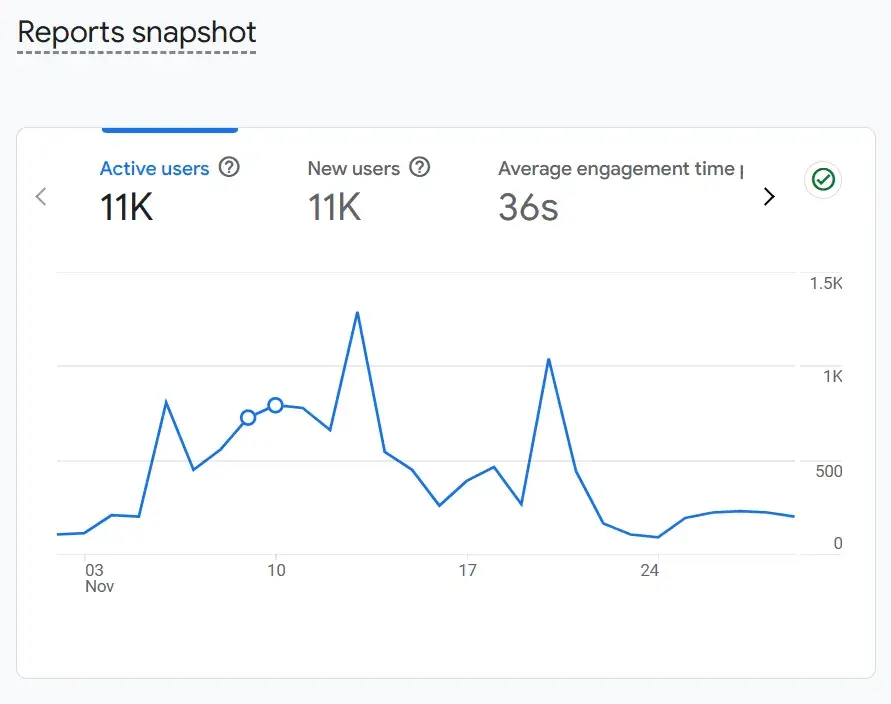
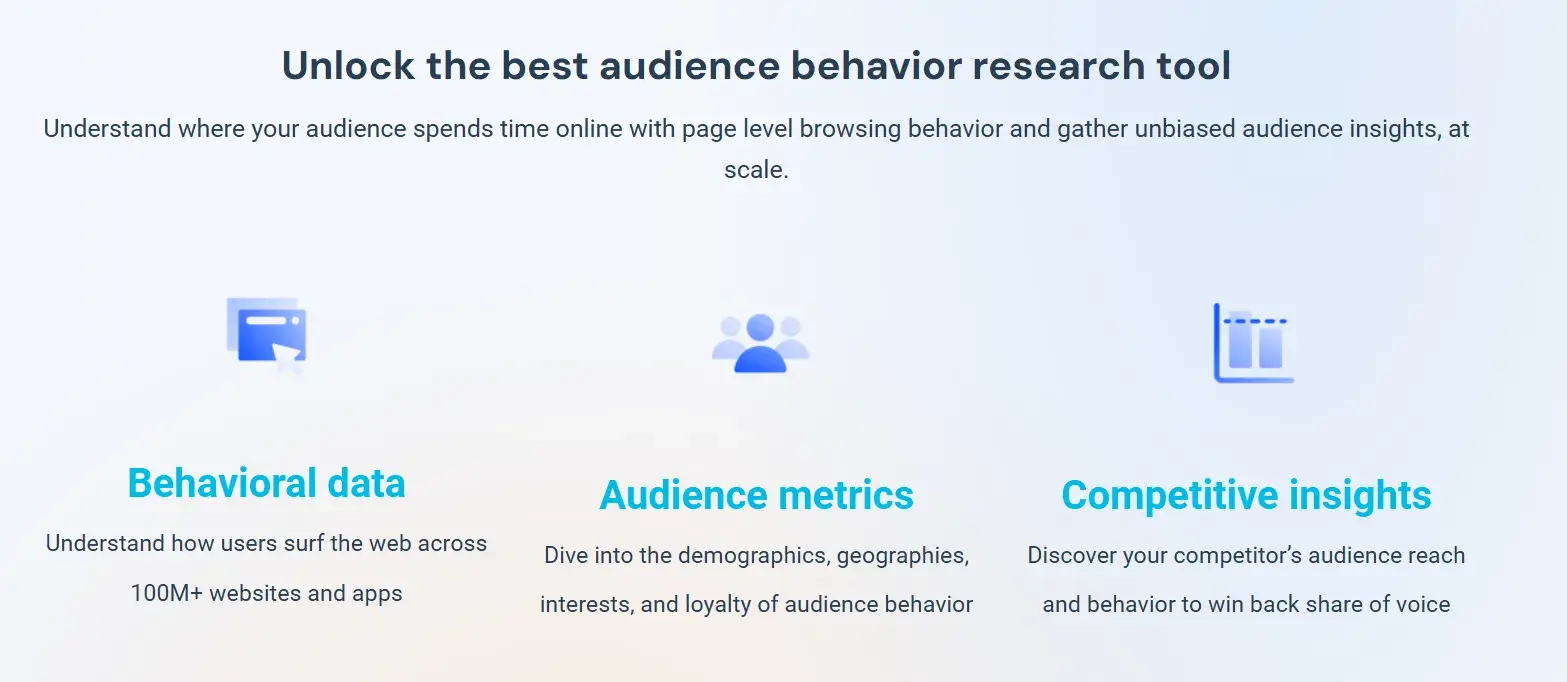
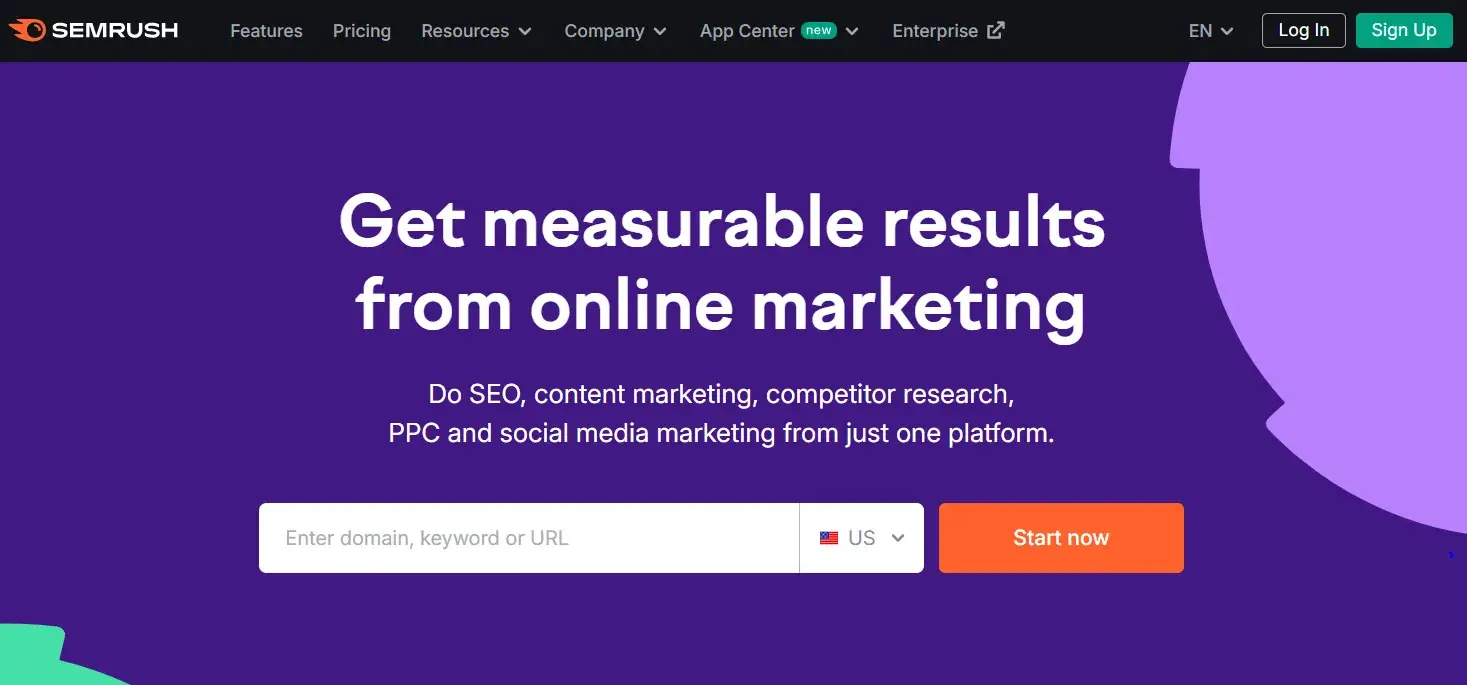
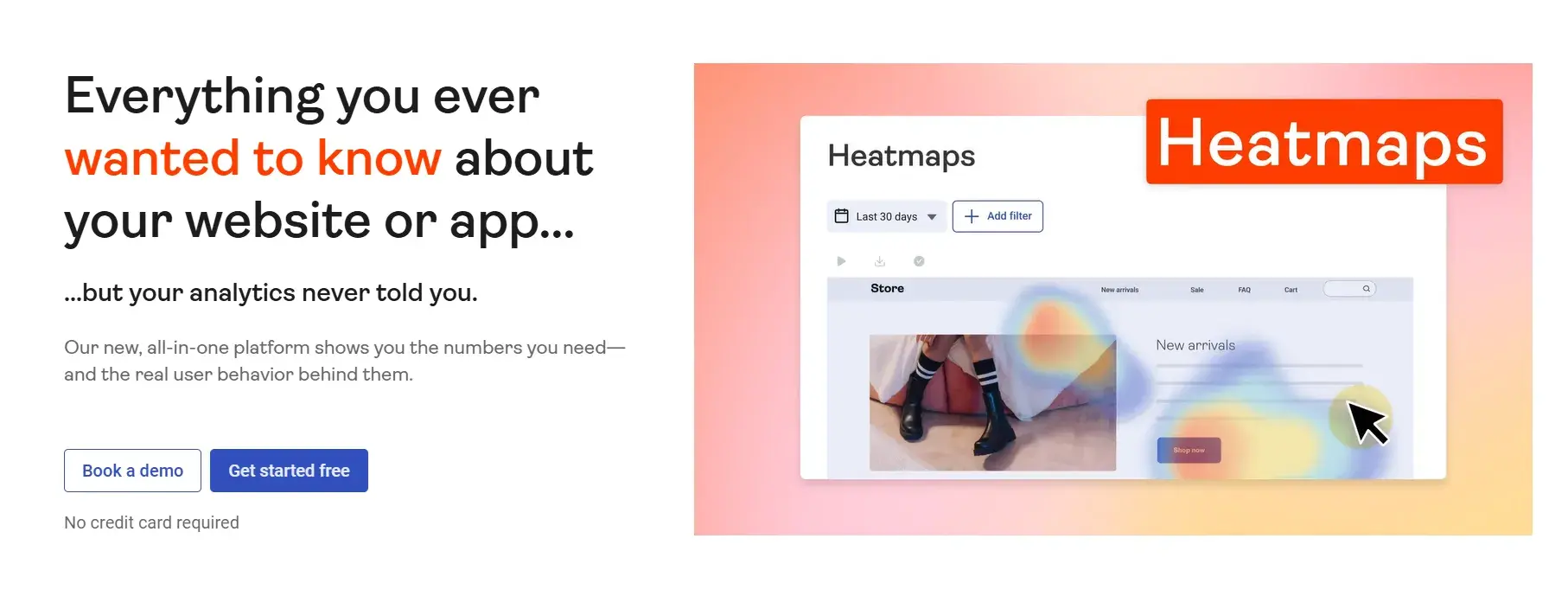
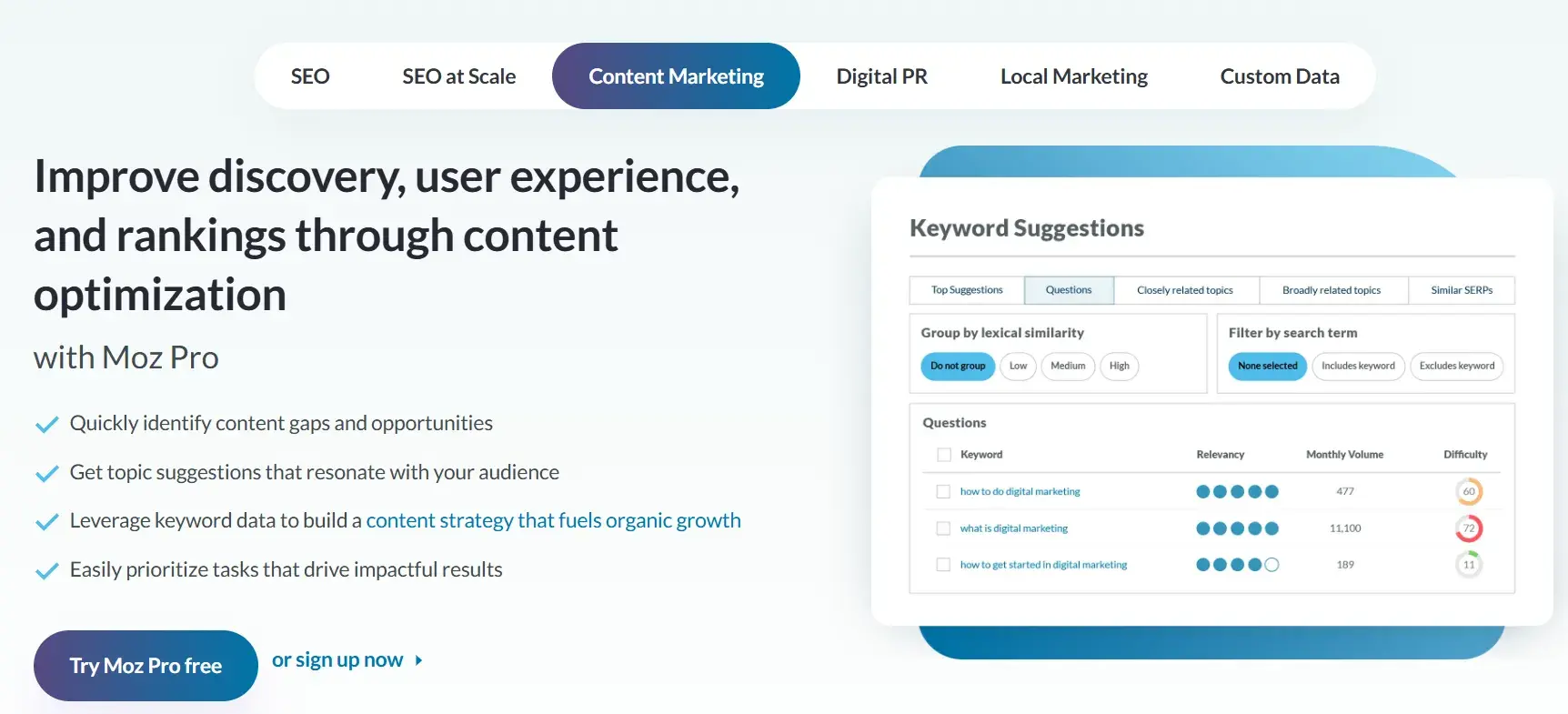

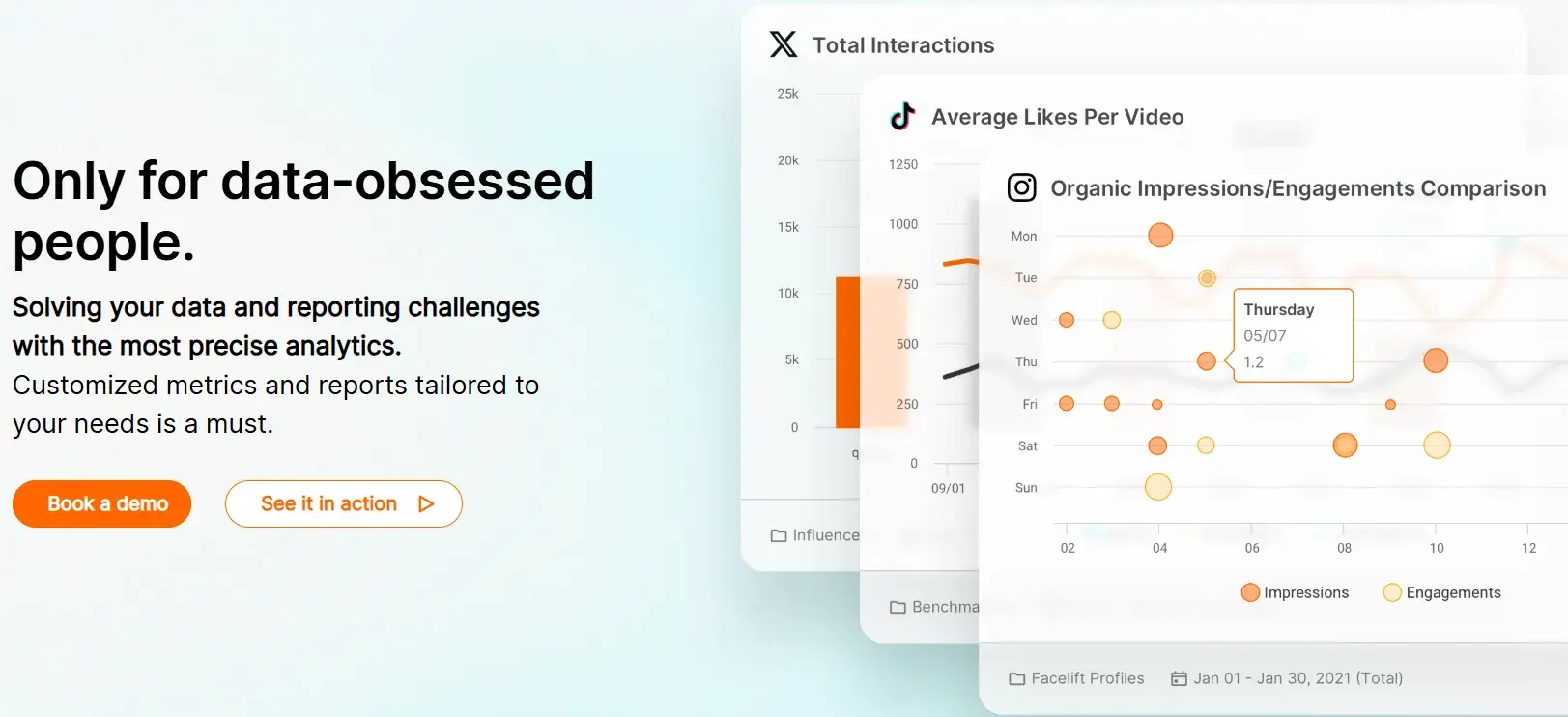
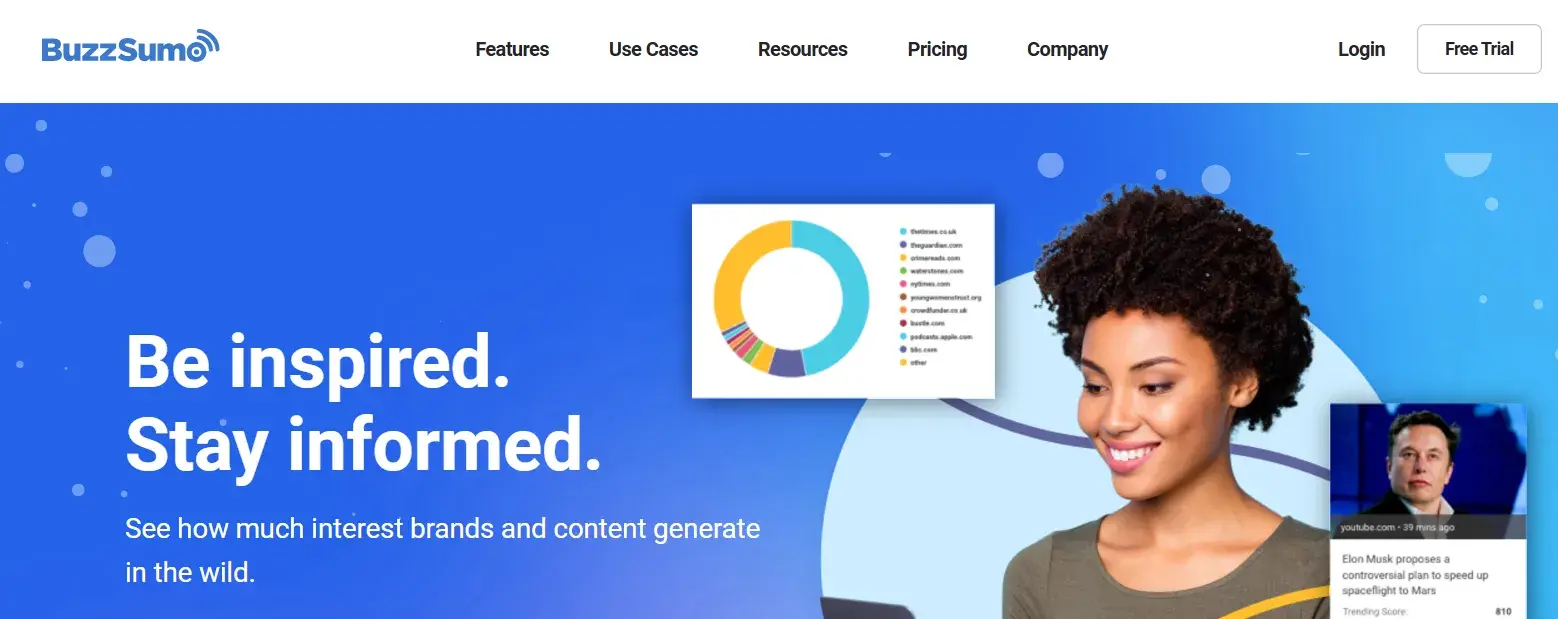
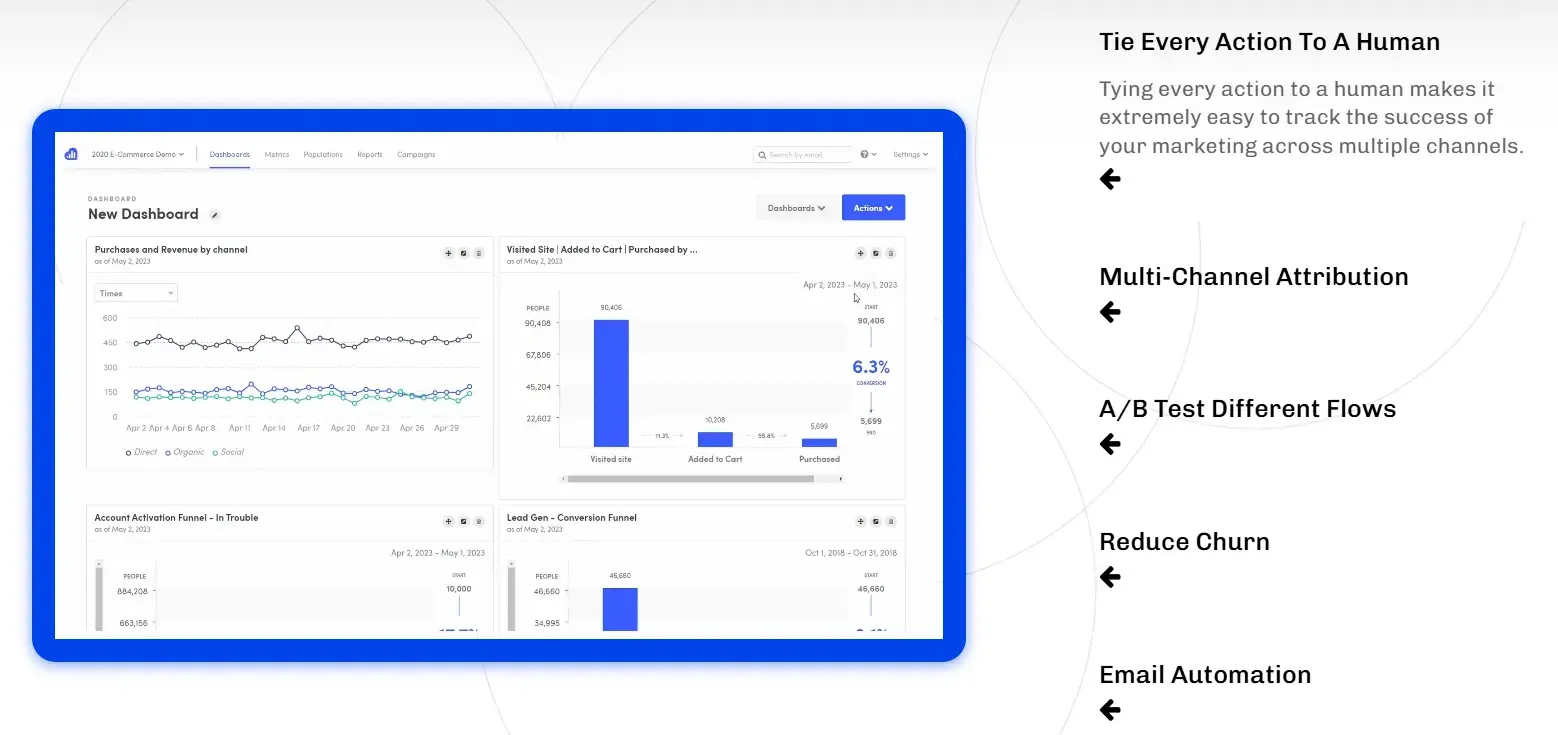
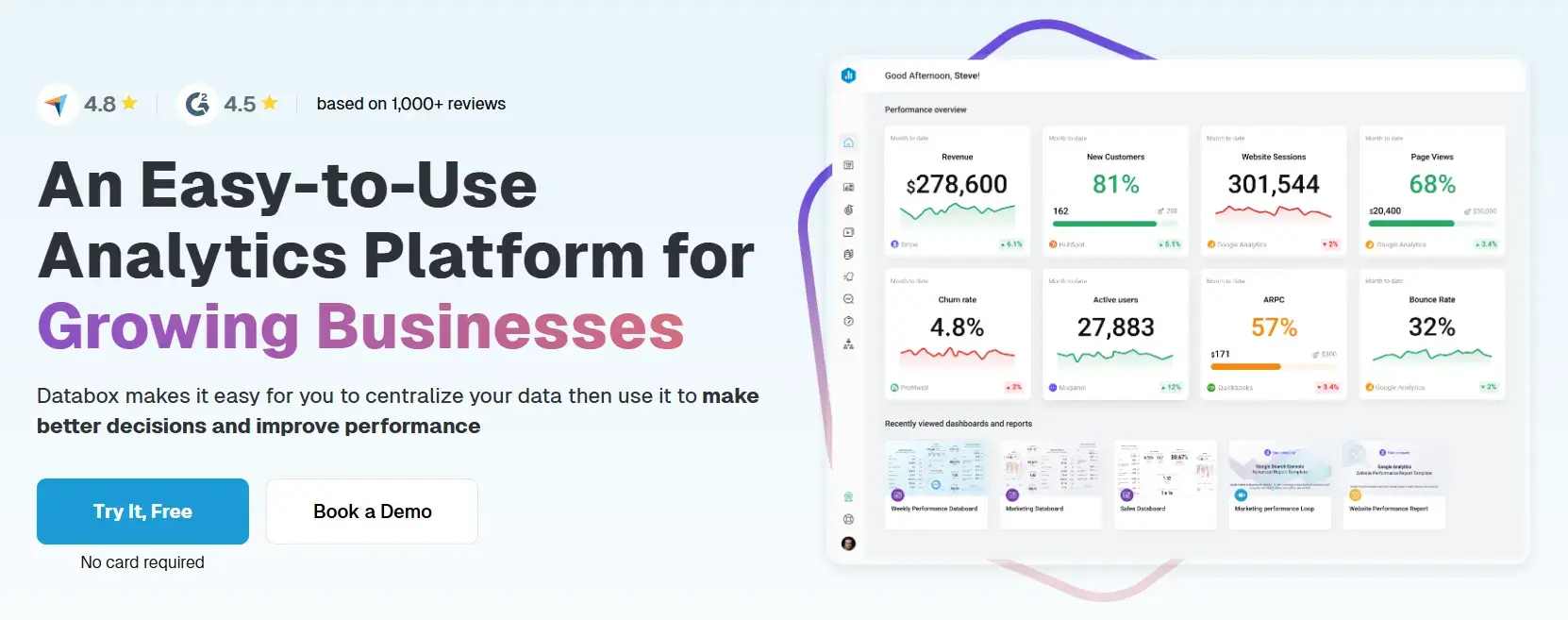
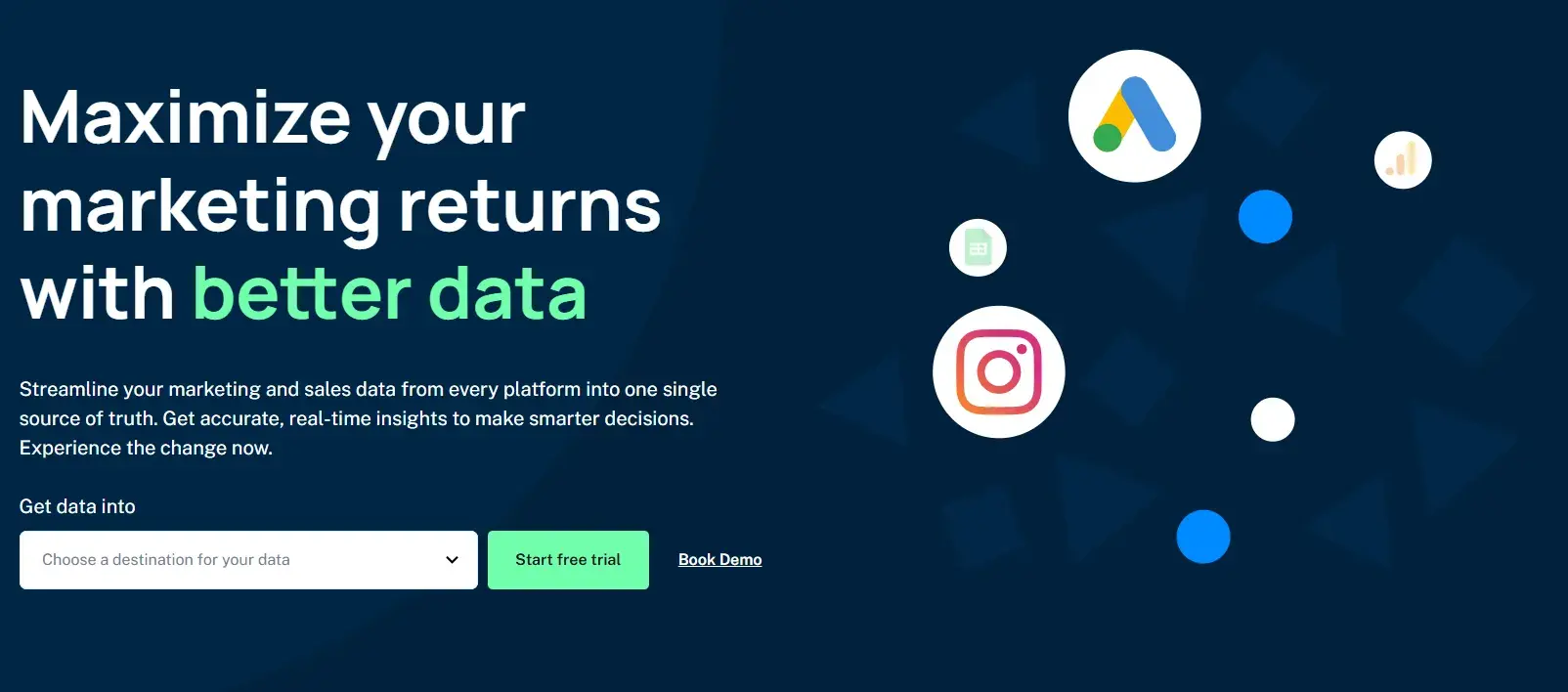
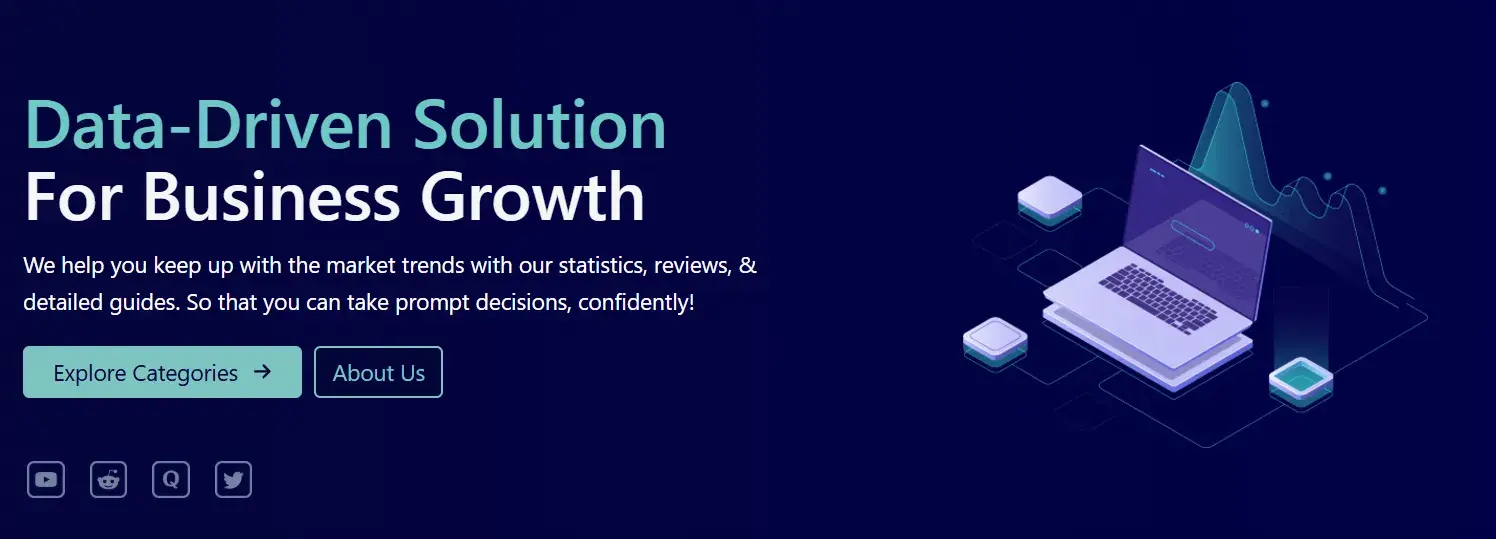
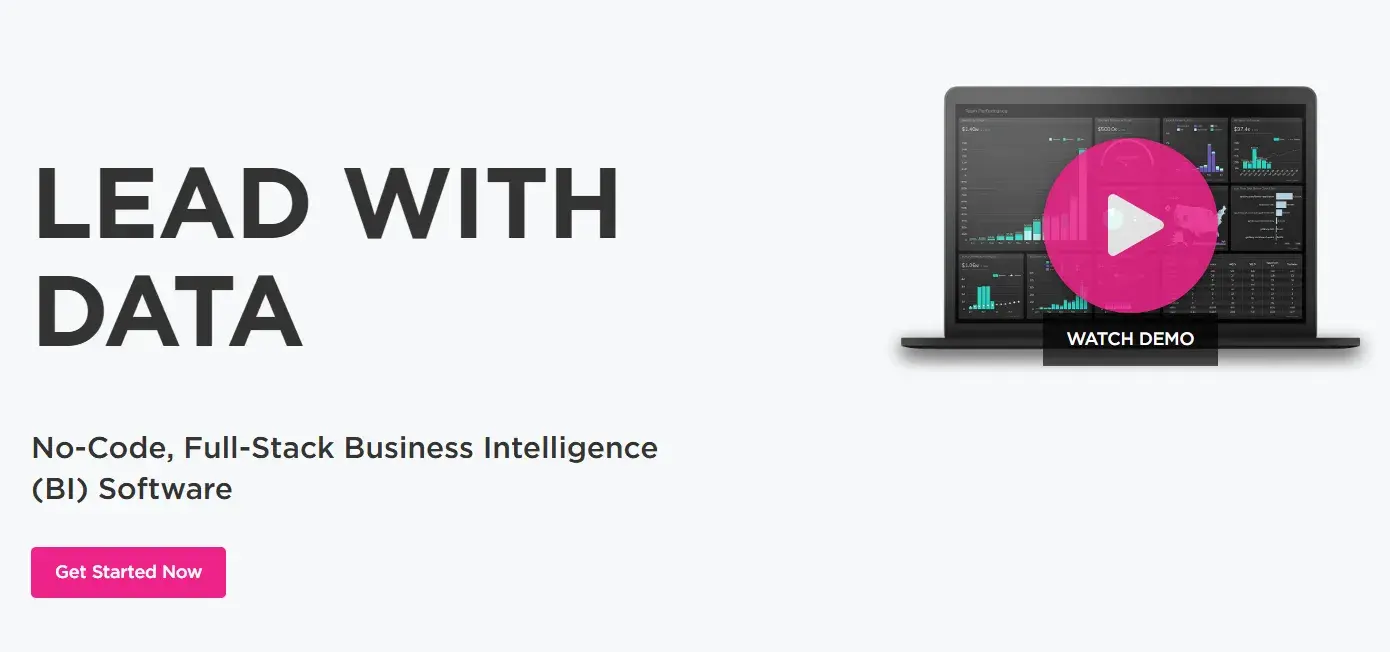
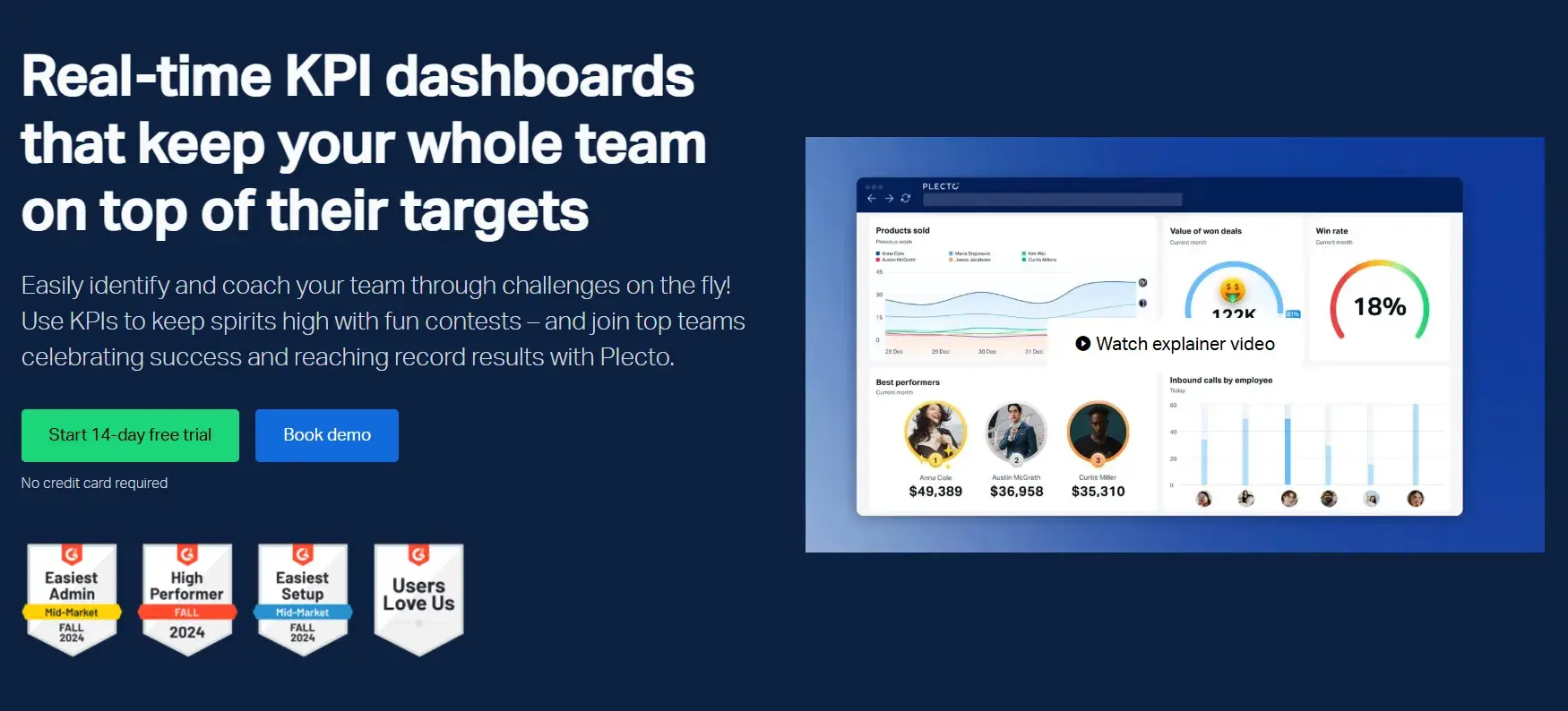
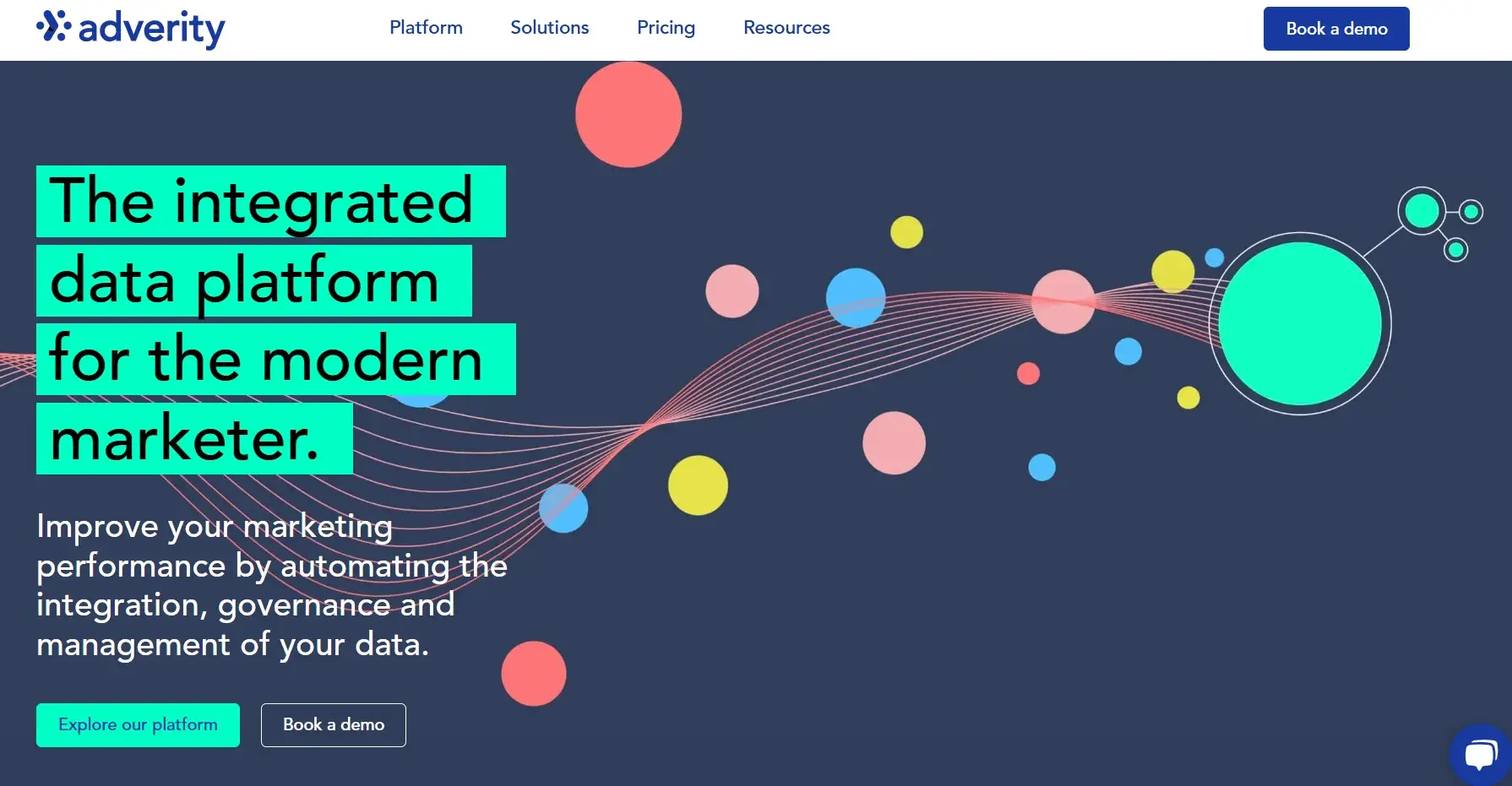
























![Download Now: Complete Guide to Collaborating at Work [Free Guide + Templates]](https://i4lead.com/wp-content/uploads/2024/12/7b7e92ee-1d6f-46e1-a984-3c0aa19eb448-1.png)
